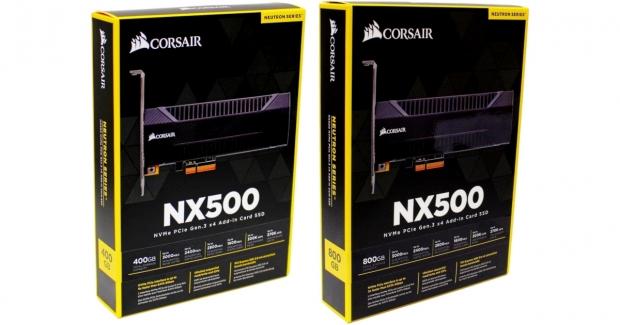
The Bottom Line
Introduction, Drive Specifications, Pricing & Availability
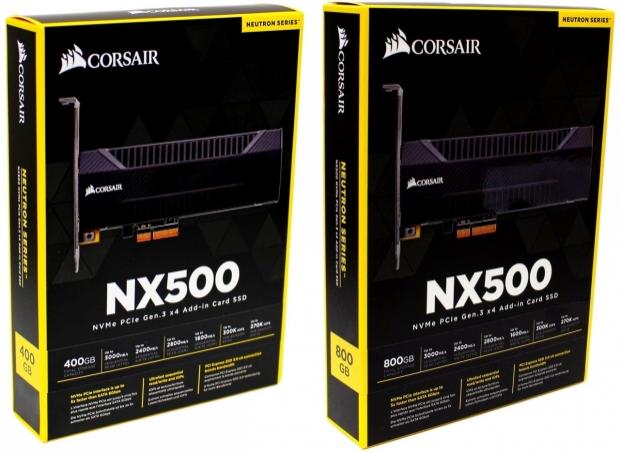
Corsair caters to PC enthusiasts like no one else. Their newest SSD, the Neutron NX500, is definitely an enthusiast grade piece of hardware. The NX500 is designed to tackle the most demanding sustained workloads you can throw at it without skipping a beat. Taking a page from Intel's playbook, Corsair's NX500 is essentially an enterprise SSD in consumer trim. The only difference between it and a full-blown enterprise SSD is a lack of capacitors for protection against host power-loss which is a relatively unnecessary feature in the consumer space.
When it comes to sustained workload performance, the main differentiator between an enterprise SSD and a consumer SSD comes down to factory overprovisioning. Overprovisioning, or OP, is space on the drives flash array that is reserved for internal drive maintenance and is not user accessible. The more OP a drive has, the better it will handle demanding workloads and the more endurance it will have. Typically, if a consumer SSD has any OP at all, it is about 7%. Corsair's NX500 has a massive 28% (4X the typical consumer OP) of its flash array dedicated for overprovisioning; 112GB for the 400GB model and 224GB for the 800GB model.
As is common with enterprise-class SSDs, the NX500 may not deliver the absolute best burst performance. However, when it comes to sustained heavy workloads, the NX500 can deliver 2-3x the performance of a typical consumer SSD as demonstrated by our brutal "Sledgehammer" test:
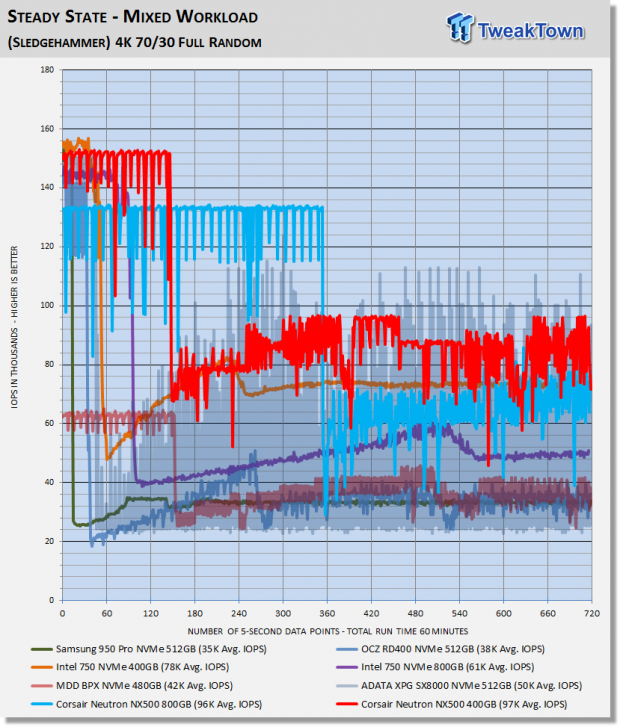
High temps go hand-in-hand with sustained heavy workloads. High temps can cause any SSD to throttle-back performance to keep from overheating. Corsair designed the NX500 with a large and highly efficient aluminum heat sink which is so effective; there isn't really anything that you can throw at the drive that will cause it to throttle. Corsair states that thermal throttling will be triggered when the temperature exceeds 80°C. Scale is decreasing performance by ~50MB/s per lowering temperature by 1°C. They also state that with the heat sink, thermal throttling won't be triggered.
Powering the NX500 is Phison's potent PS5007-E7 (or E7) NVMe SSD controller. The Phison E7 has earned a reputation for blazing fast low-latency performance and extreme reliability, making it ideal for enthusiast grade SSDs. Corsair pairs the E7 controller with a high-grade and potent BGA packaged Toshiba 15nm Toggle MLC Planar NAND-flash array and a DDR3 DRAM cache with a 2MB to 1GB ratio. The DDR3 DRAM cache on the NX500 is twice that of any other consumer SSD on the market.
The Corsair NX500 has all the attributes that make for an exceptional enthusiast grade SSD, now let's take a detailed look at its factory specifications, and get these powerhouses on the bench.
Specifications
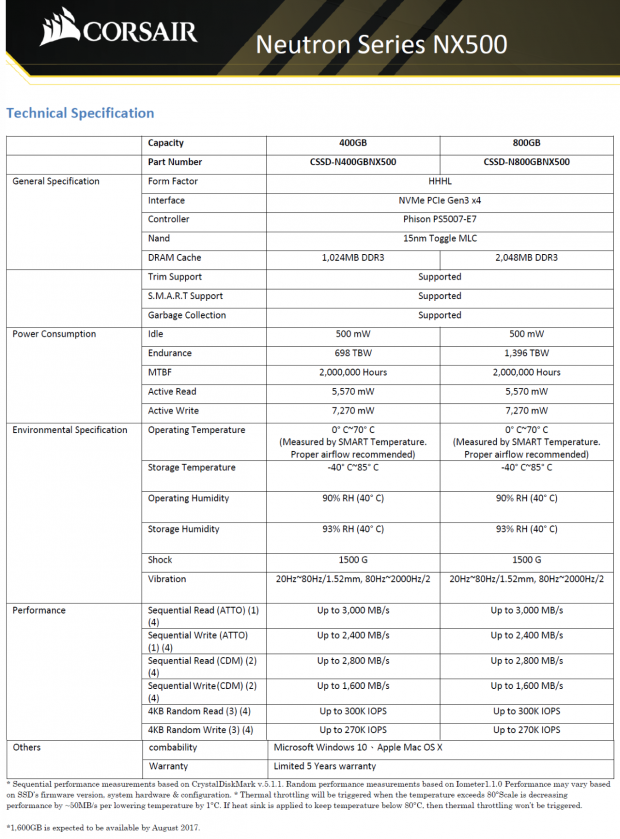
The Corsair NX500 AIC NVMe SSD is currently available in two capacities: 400GB and 800GB. A 1.6TB model is expected to be available in the coming months.
- Sequential Read: up to 3,000 MB/s (ATTO)
- Sequential Write: up to 2,400 MB/s (ATTO)
- Sequential Read: up to 2,800 MB/s (CDM)
- Sequential Write: up to 1,600 MB/s (CDM)
- Max 4K Random Read Speed: up to 300,000 IOPS
- Max 4K Random Write Speed: up to 270,000 IOPS
- Endurance: 400GB up to 698 TBW
- Endurance: 800GB up to 1,396 TBW
- MTBF: 2 Million Hours
- Warranty: 5-Year Limited Warranty
- SMART
- TRIM
- Garbage Collection
MSRP: 400GB = $319.99 MSRP: 800GB = $649.99
Features
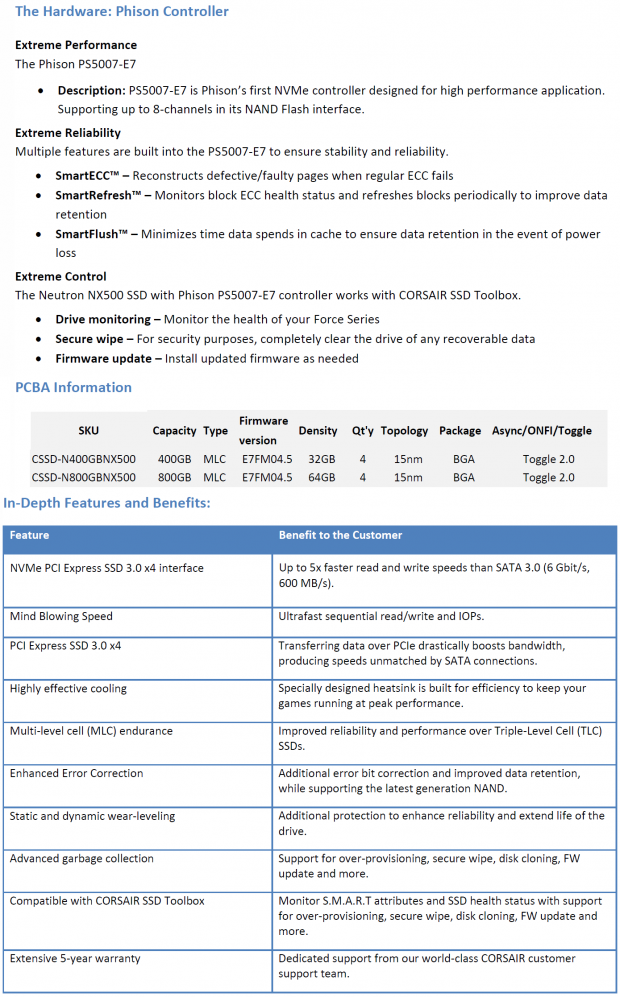
The Phison E7 controller is designed for high performance over a Gen3 x4 PCIe NVMe interface. The E7 controller sports four CPU cores and eight NAND channels. Multiple features are built into the Phison E7 controller to ensure stability and reliability. These features include SmartECC which reconstructs defective/faulty pages when regular ECC fails, SmartRefresh monitors block ECC health status and refreshes blocks periodically to improve data retention and SmartFlush minimizes time data spends in cache to ensure data retention in the event of power loss.
Drive Details
Corsair Neutron NX500 AIC PCIe NVMe SSD
Both the 400GB and 800GB models are physically identical and have identical performance specifications, so we are only showing the 400GB model in detail.
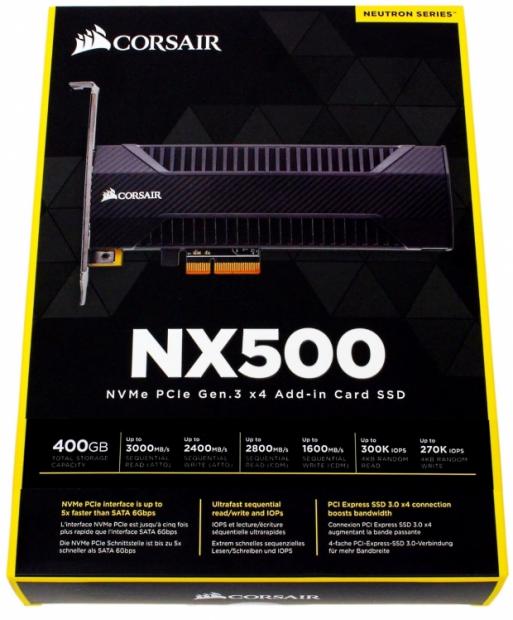
As is common for Corsair, the packaging is a work of art. The pictures and some of the text are raised and embossed. The packaging is black and yellow themed. This side of the packaging features a picture of the enclosed SSD, advertises the drive's capacity, interface and lists various factory performance specifications.
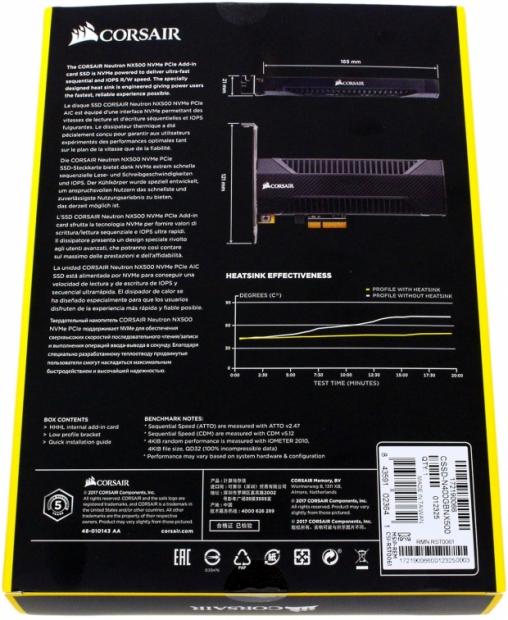
The back of the packaging lists a bit of pertinent information about the physical size of the enclosed SSD and the effectiveness of its heat sink. The included optional low-profile bracket is also advertised here.
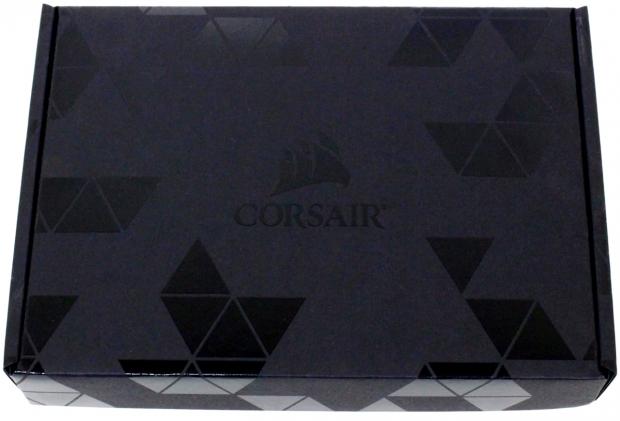
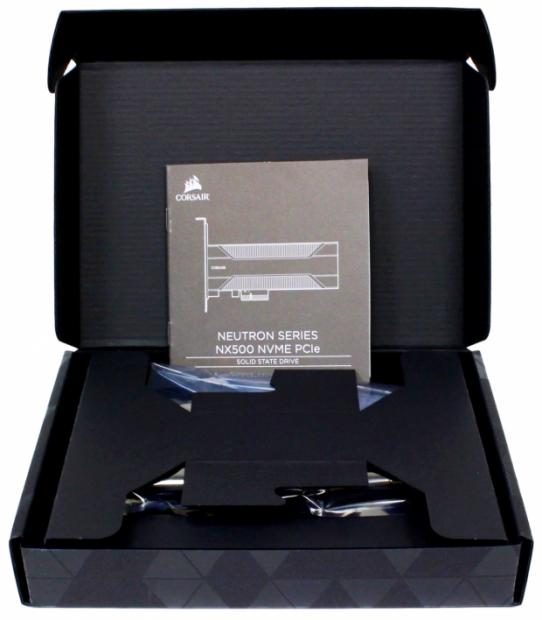
Inside of the colorful outer packaging is a heavy-duty black flip-top cardboard box that is also handsomely decorated.
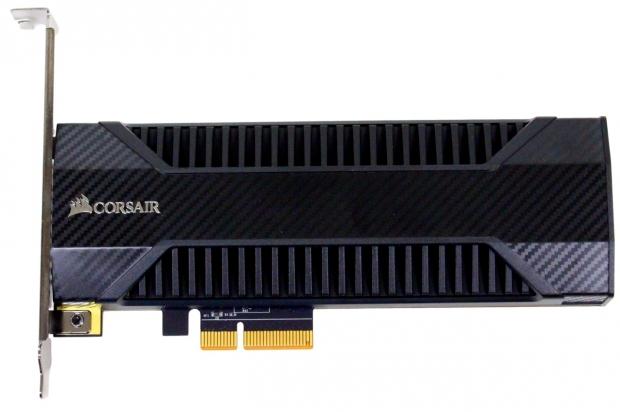
The heat sink side of the SSD is accented by an attractive carbon-fiber pattern. The drive's solid aluminum heat sink is finned for maximum thermal dissipation.
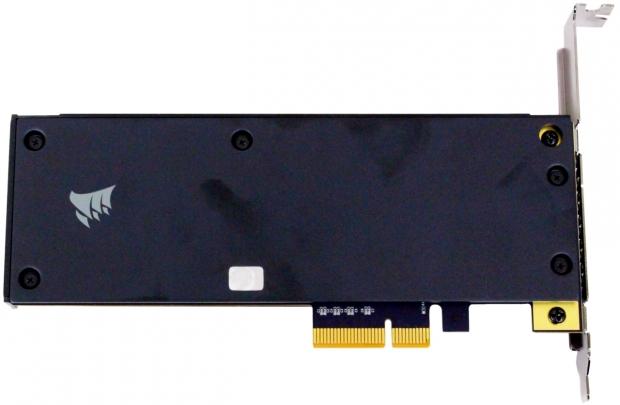
The back half of the drive's full-length PCB is covered by a sturdy metal back-plate that attaches to the heat sink on the opposite side with six screws; one of which is covered with a tamper resistant label. Removing the label will void the warranty.
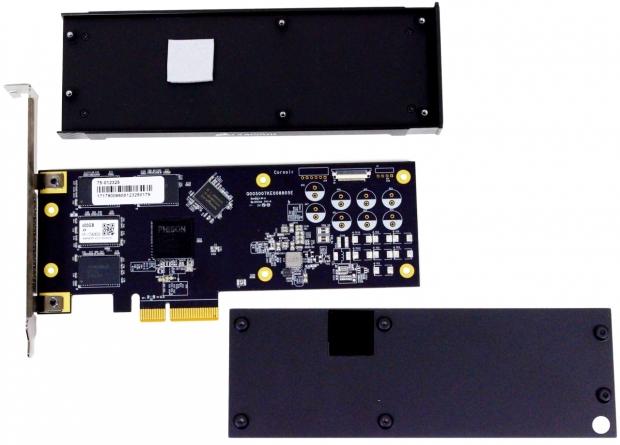
Removing the heat sink and back-plate reveals the drive's dark blue full-length PCB.
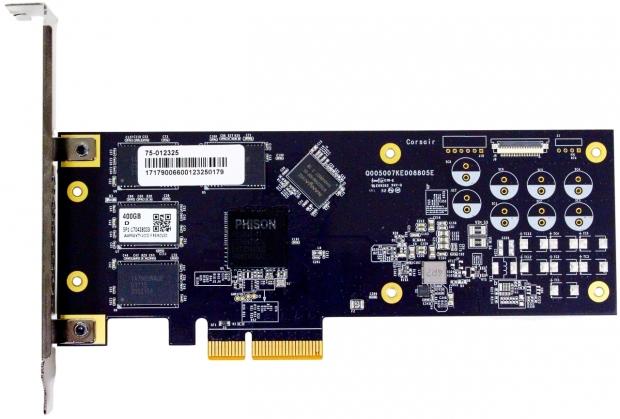
This side of the PCB houses the drive's Phison E7 controller, four Toshiba 15nm MLC flash packages and a 512MB Nanya DDR3 1600MHz DRAM cache package.
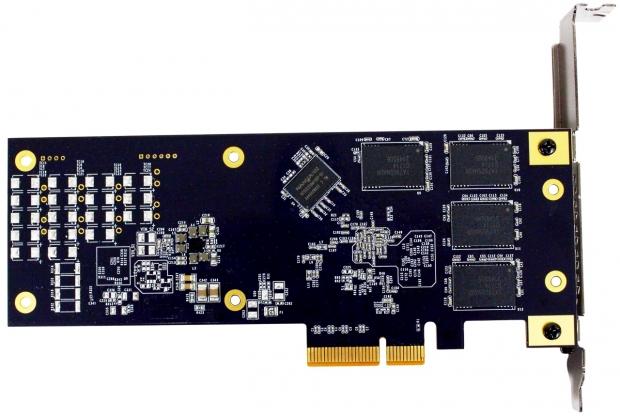
This side of the PCB houses an additional four Toshiba 15nm MLC flash packages and another 512MB Nanya DDR3 1600MHz DRAM cache package.
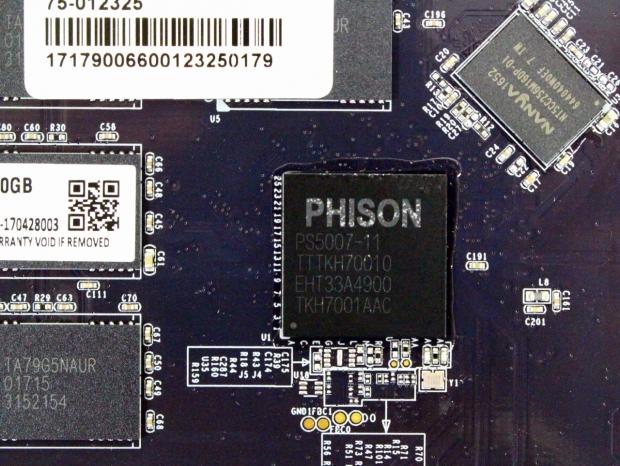
A close-in view of the drive's Phison E7 controller.
Test System Setup, Drive Properties & SSD Toolbox
Jon's Consumer PCIe SSD Intel Review Test System Specifications
- Motherboard: ASRock OC Formula Z170 - Buy from Amazon / Read our review
- CPU: Intel Core i7 6700K @ 4.7GHz - Buy from Amazon / Read our review
- Cooler: Swiftech H2O-320 Edge - Buy from Amazon / Read our review
- Memory: Corsair Vengeance LPX DDR4 16GB 3200MHz - Buy from Amazon
- Video Card: Onboard Video
- Case: IN WIN X-Frame - Buy from Amazon / Read our review
- Power Supply: Seasonic Platinum 1000 Watt Modular - Buy from Amazon / Read our review
- OS: Microsoft Windows 10 Professional 64-bit - Buy from Amazon
- Drivers: MS Win 10 NVMe driver
We would like to thank ASRock, Crucial, Intel, Corsair, RamCity, IN WIN, and Seasonic for making our test system possible.
Drive Properties
Corsair Neutron NX500 400GB AIC PCIe NVMe SSD OS Disk 75% Full
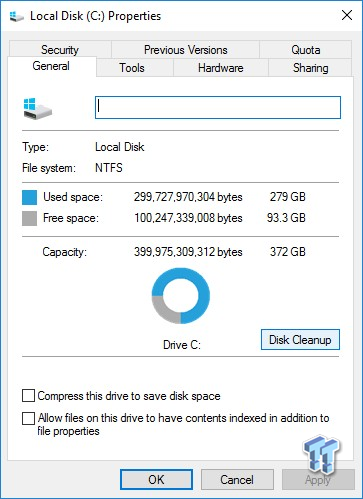
Corsair Neutron NX500 800GB AIC PCIe NVMe SSD OS Disk 75% Full
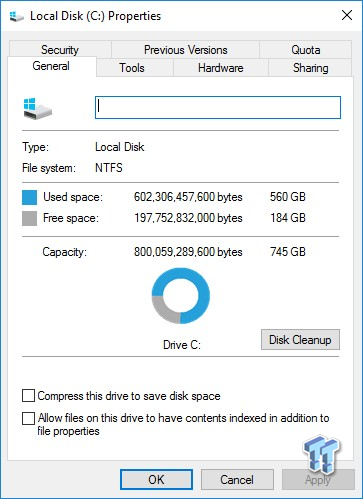
The majority of our testing is performed with our test drive as our boot volume. Our boot volume is 75% full for all OS Disk "C" drive testing to replicate a typical consumer OS volume implementation. We feel that most of you will be utilizing your SSDs for your boot volume and that presenting you with results from an OS volume is more relevant than presenting you with empty secondary volume results.
System settings: Cstates and Speed stepping are both disabled in our systems BIOS. Windows High-Performance power plan is enabled. Windows write caching is enabled, and Windows buffer flushing is disabled. We are utilizing Windows 10 Pro 64-bit OS (Build 14393) for all of our testing except for our MOP (Maxed-Out Performance) benchmarks where we switch to Windows Server 2012 R2 64-bit. Empty Windows 10 benchmark screenshots will also be shown on our MOP page.
Please note: When comparing our results to those of other review sites, look at page 10 Maxed Out Performance-Windows 10 which is done with the disk empty.
Benchmark screenshots will be shown 400GB model first followed by the 800GB model.
In choosing our test pool, we selected drives with MLC flash arrays and similar capacity points.
Corsair SSD Toolbox
Corsair's SSD Toolbox is fully compatible with the NX500 Series. The toolbox makes drive maintenance and OS Migration (Disk Cloning) simple and easy to understand.
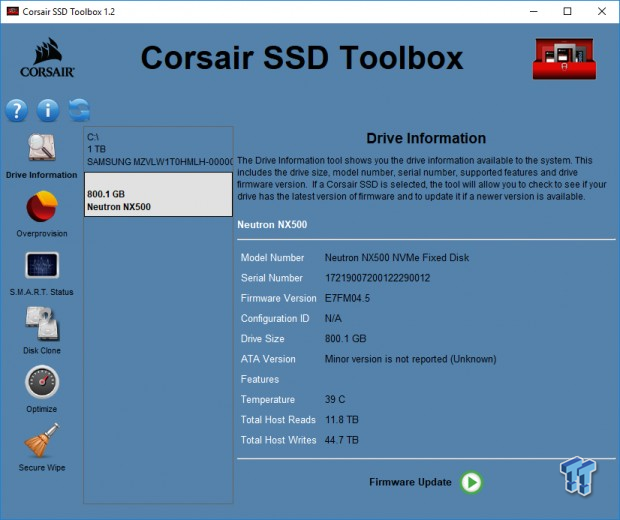
Drive information tells us what firmware is on the drive and the drive's temperature, which is a cool 39°C. You can easily update the drive's firmware with a couple of clicks.
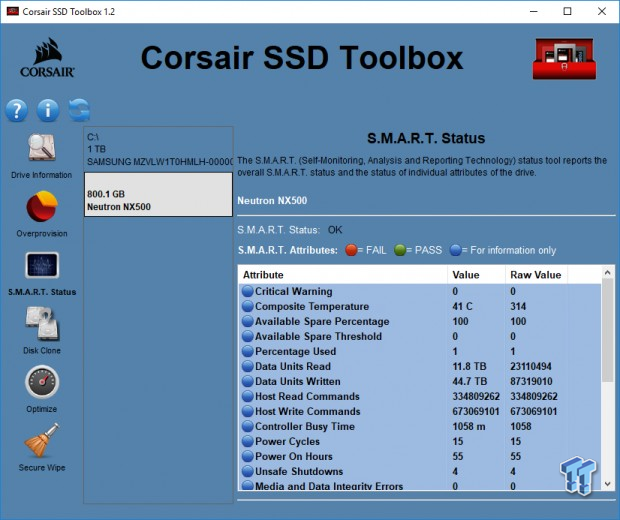
The drive's S.M.A.R.T. status can be read from the S.M.A.R.T. Status tab.
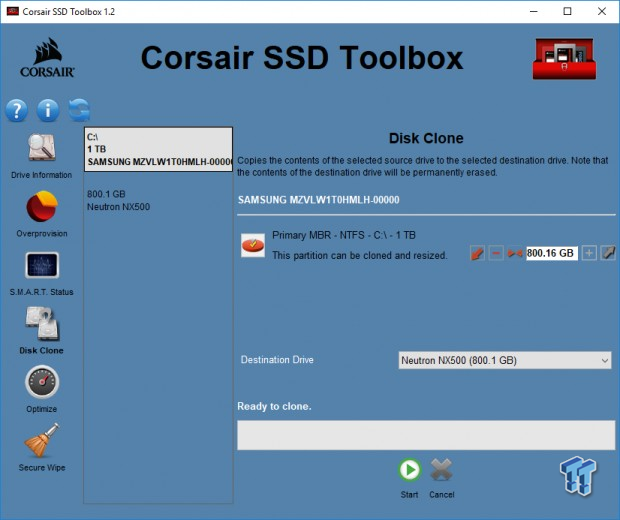
From here, you can easily clone the NX500. The optimize tab will TRIM the drive if you are running Windows 7. For Windows 8.1 and 10 this feature is handled by the OS.
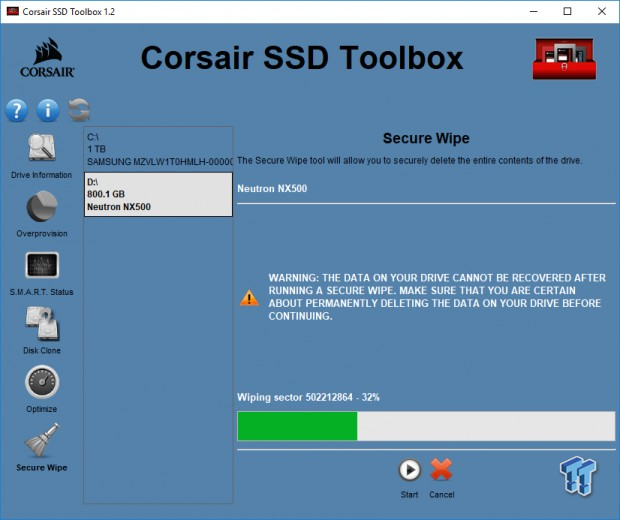
And last, but not least, you can Secure Wipe your NX500 SSD from the Secure Wipe Tab. The Secure Wipe will take 5-10 minutes to complete depending on the drive's capacity because each sector is completely wiped.
Synthetic Benchmarks – ATTO & Anvil Storage Utilities
ATTO
Version and / or Patch Used: 3.05
ATTO is a timeless benchmark used to provide manufacturers with data used for marketing storage products. When evaluating ATTO performance, we focus on the drive's performance curve.
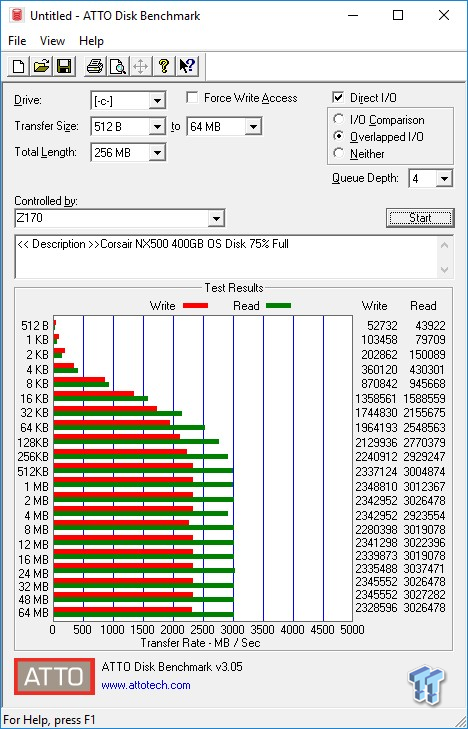
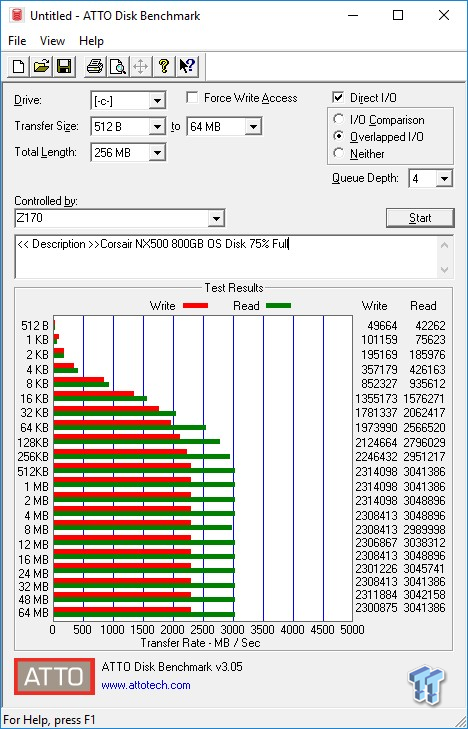
Like all Phison E7 powered SSDs, the NX500 digests compressible data particularly well. The 400GB model writes sequential compressible data a bit faster than the 800GB model. The 800GB model reads sequential compressible data a bit faster than the 400GB. The slight differences between the two capacity points are most likely just variability between runs and not actual performance differences per se.
Sequential Write
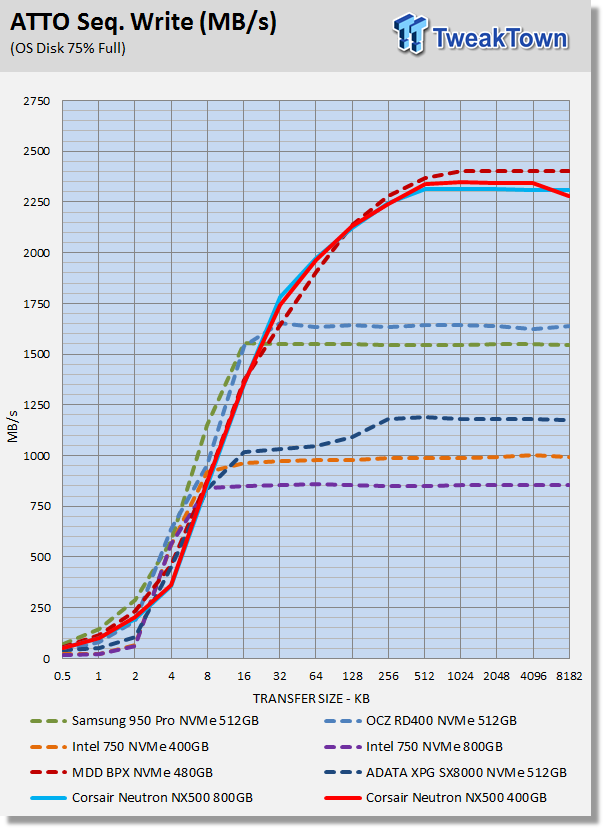
Graphing the performance curve displays the what we typically see from E7 powered SSDs. The NX500's and the MDD BPX (both E7 Powered SSDs) leave the test pool behind at file sizes of 32KB and larger. E7 powered SSDs handle compressible data differently than they do incompressible data.
Sequential Read
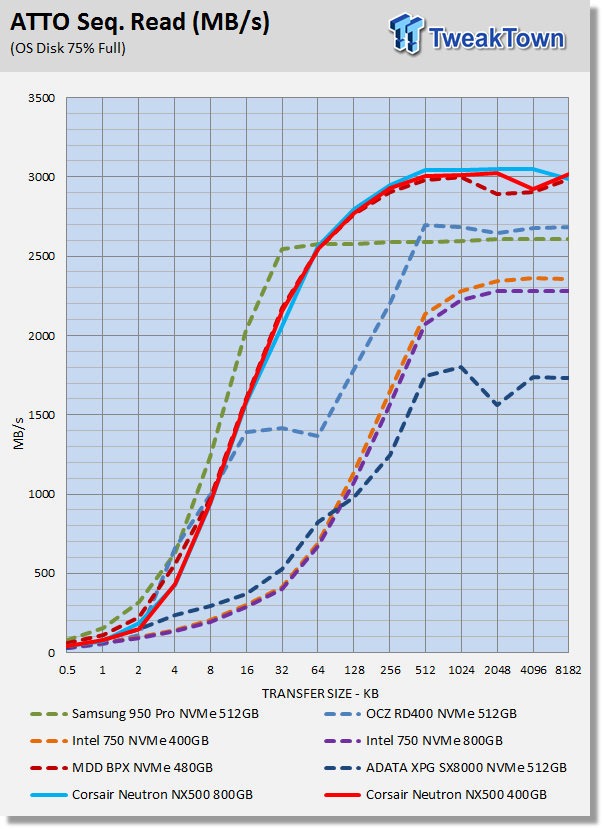
The 950 Pro delivers superior small-file sequential read performance. The NX500 delivers a better performance curve than the rest of the drives in our test pool except the 950 Pro. We place a higher importance on small-file performance with this testing which is why we give the win to the 950 Pro.
Anvil Storage Utilities
Version and / or Patch Used: 1.1.0
Anvil's Storage Utilities is a storage benchmark designed to measure the storage performance of SSDs. The Standard Storage Benchmark performs a series of tests; you can run a full test or just the read or write test, or you can run a single test, i.e. 4k QD16. When evaluating performance with Anvils, we focus on the total score. When evaluating NVMe SSDs, we are typically looking for a minimum total score of over 10K. We place a greater importance on read performance than write performance.
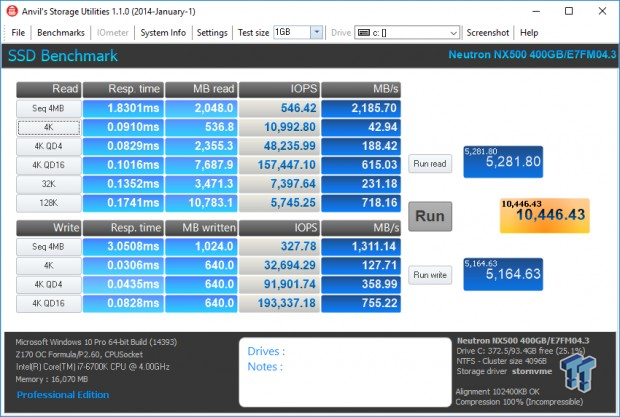
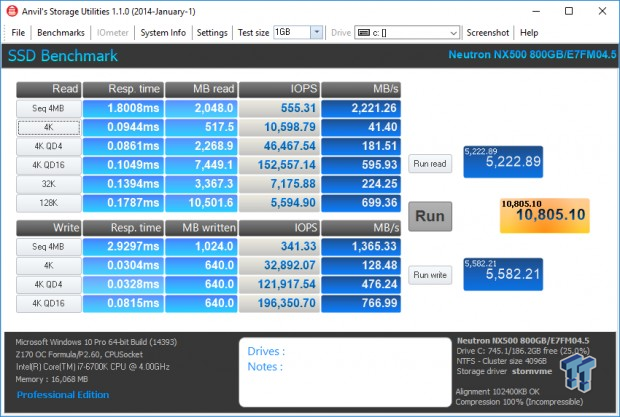
Scoring
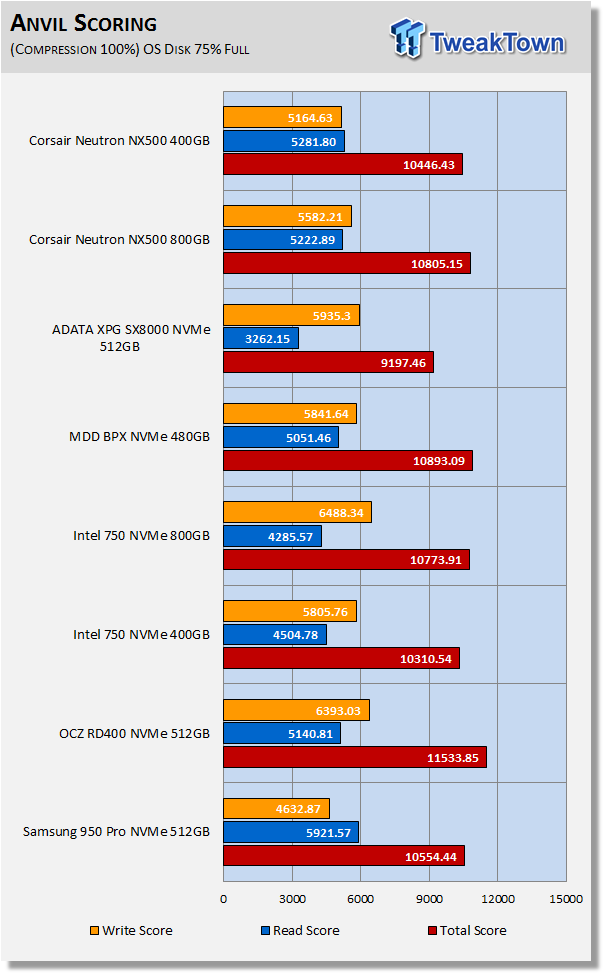
In terms of total score, the 800GB NX500 delivers the third best score, and the 400GB NX500 comes in second to last. Now if we dig a little deeper, we see that the when it comes to read performance, the NX500 is a beast. Of the drives in our test pool, only the 950 Pro outperforms the NX500 when reading data. We place a higher importance on read performance than write and the NX500 gives us what we are looking for.
(Anvil) Read IOPS through Queue Depth Scale
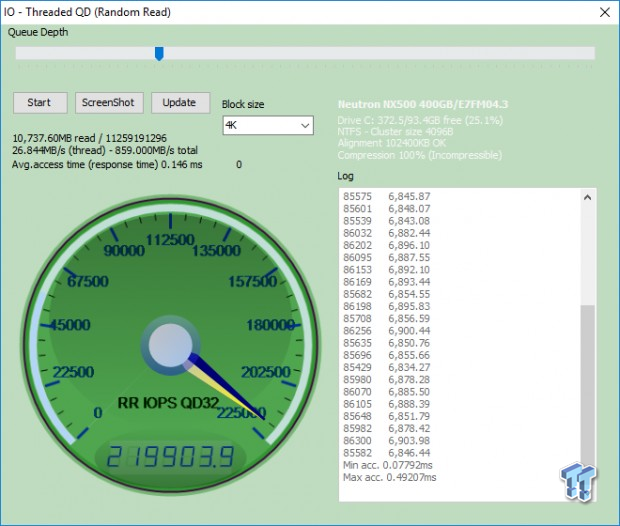
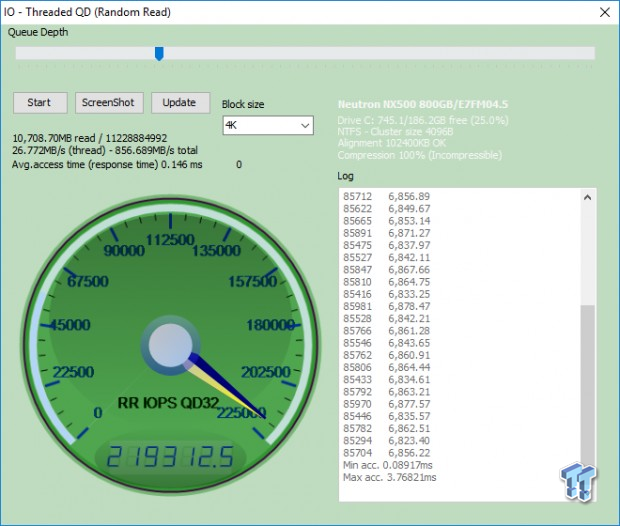
Both capacities hit 291K random read IOPS at QD32 as OS disks 75% full.
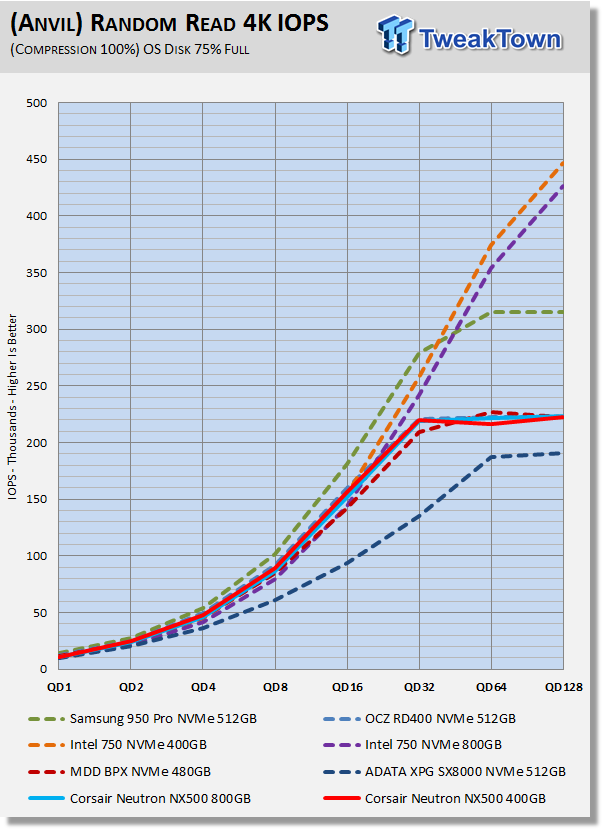
Here we see the NX500 preforming very similar at both capacity points. The NX500 is running almost identical to OCZ's RD400. The NX500's are both outperforming the MDD BPX. ADATA's SX800 brings up the rear by delivering substandard read performance. The Intel 750's don't start delivering the goods until we hit QD16.
(Anvil) Write IOPS through Queue Scale
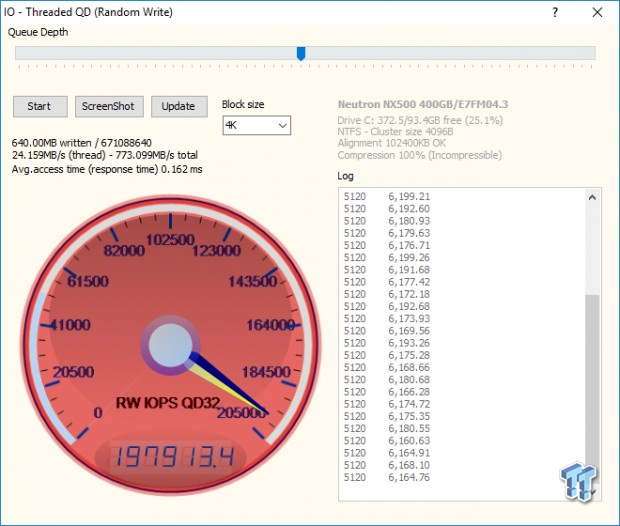
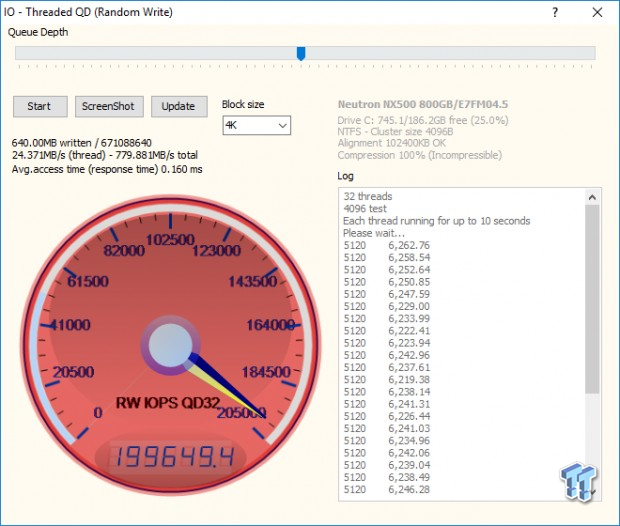
We are able to attain 197K random write IOPS at QD32 with the 400GB NX500, 918K with the 800GB model. It is important to keep in mind that our results are with the drive running as our OS disk 75% full.
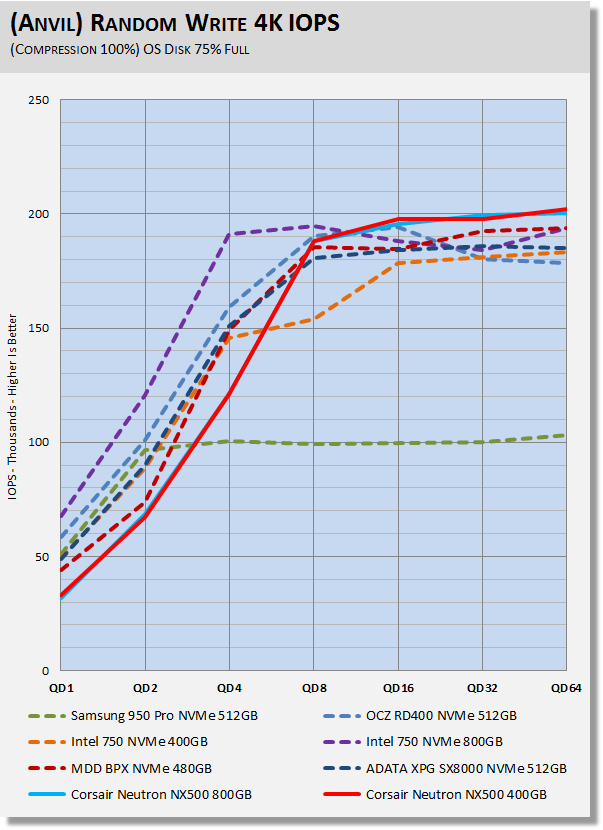
At queue depths of 1-4, the NX500 is being outperformed by the MDD BPX. Both the NX500 and BPX are E7 based SSDs. The reason the BPX is outperforming the NX500 at low queue depth is due to firmware. The BPX is running on earlier firmware (2.1) that allocates more of the drives flash array for SLC cache. Phison 4.x series firmware allocates much less of the drives flash array for SLC cache.
When we hit QD8, the NX500 overtakes the BPX and doesn't look back. At QD16, the NX500 overtakes the rest of the drives in our test pool and holds that advantage on through to QD64. We place a greater importance on performance at low queue depths. Intel's 800GB 750 series delivers the best low queue depth performance of the bunch.
Synthetic Benchmarks – CrystalDiskMark & AS SSD
CrystalDiskMark
Version and / or Patch Used: 3.0 Technical Preview
CrystalDiskMark is disk benchmark software that allows us to benchmark 4k and 4k queue depths with accuracy. Note: Crystal Disk Mark 3.0 Technical Preview was used for these tests since it offers the ability to measure native command queuing at QD4. When evaluating CDM results, we focus on 4K random performance at QD1 and QD4.
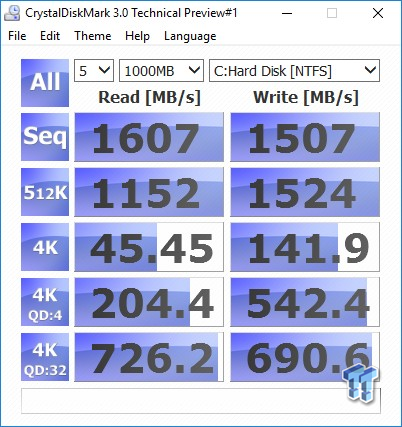
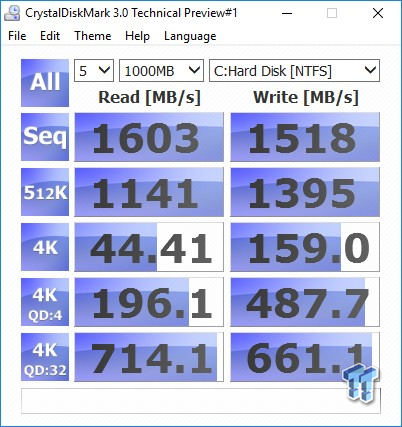
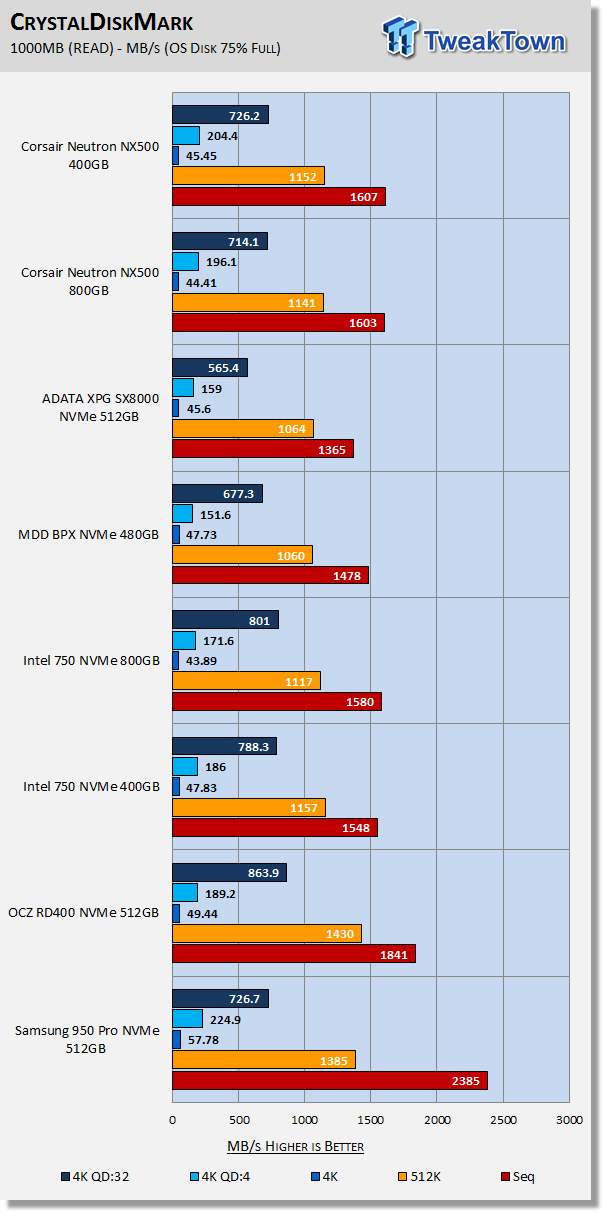
Focusing in on QD1 and QD4 reveals the 400GB NX500 holding an advantage over the 800GB model. At QD1, the NX500 is outperformed by several of the SSDs in our test pool. At QD4, the NX500 beats all of the contenders in our test pool except Samsung's 950 Pro which is a juggernaut when it comes to read performance.
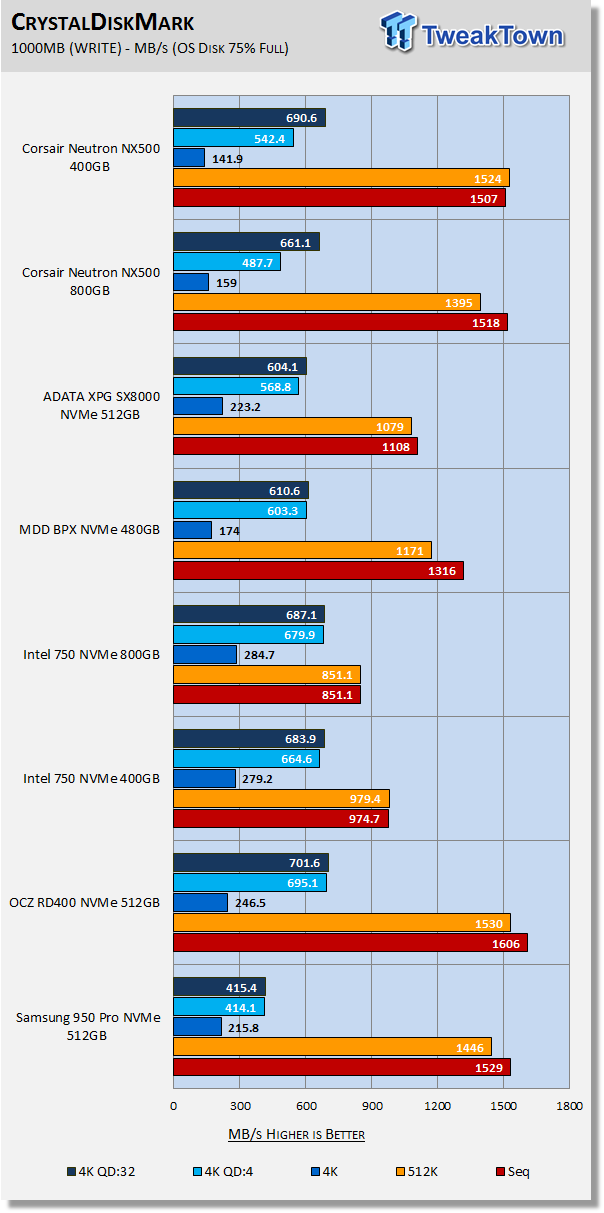
The smaller SLC cache that comes with Phison 4.x series firmware handicaps random write performance at low queue depths. We can see this by comparing the NX500 to MDD's BPX. We believe that Phison is somehow gaining sequential performance at the expense of random performance. Look at how much better the NX500's sequential performance at QD1 is in comparison to the BPX.
AS SSD
Version and / or Patch Used: 1.8.5611.39791
AS SSD determines the performance of SSDs. The tool contains four synthetic as well as three practice tests. The synthetic tests are to determine the sequential and random read and write performance of the SSD. We evaluate AS SSD performance in terms of overall score. We are looking for a minimum score of 2,000 when evaluating NVMe SSDs
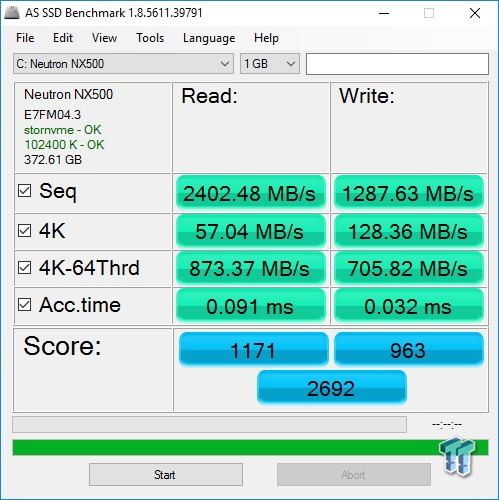
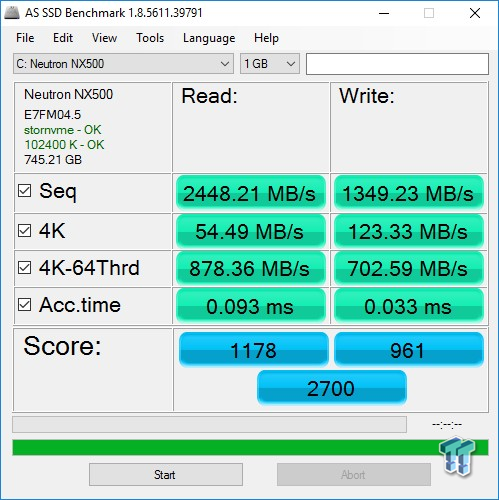
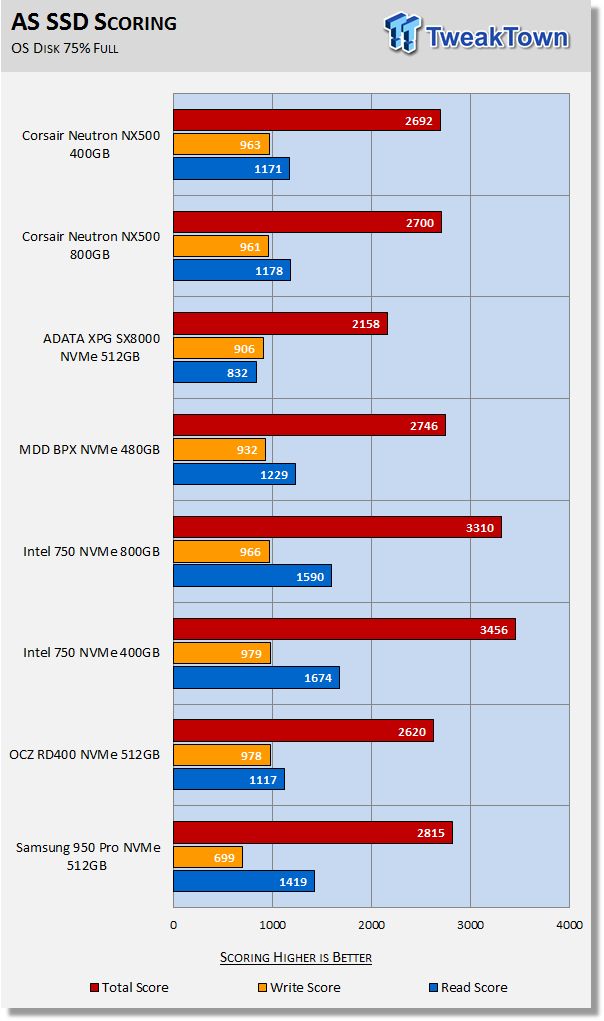
AS SSD is a demanding test, and the NX500 has no problem exceeding our minimum standard of 2,000 at both capacity points. The BPX with its larger cache manages to deliver a better score than the NX500 despite being a lower grade SSD than the NX500. Intel's 750 series SSD's dominate the scoring due to their 18-channel controller's superior multi-threaded random read performance.
Benchmarks (OS) - Vantage, PCMark 7, PCMark 8 & SYSmark 2014 SE
Moderate Workload Model
We categorize these tests as indicative of a moderate workload environment.
PCMark Vantage - Hard Disk Tests
Version and / or Patch Used: 1.2.0.0
The reason we like PCMark Vantage is because the recorded traces are played back without system stops. What we see is the raw performance of the drive. This allows us to see a marked difference between scoring that other trace-based benchmarks do not exhibit. An example of a marked difference in scoring on the same drive would be empty vs. filled vs. steady state.
We run Vantage three ways. The first run is with the OS drive 75% full to simulate a lightly used OS volume filled with data to an amount we feel is common for most users. The second run is with the OS volume written into a "Steady State" utilizing SNIA's consumer guidelines. Steady state testing simulates a drive's performance similar to that of a drive that been subjected to consumer workloads for extensive amounts of time. The third run is a Vantage HDD test with the test drive attached as an empty, lightly used secondary device.
OS Volume 75% Full - Lightly Used
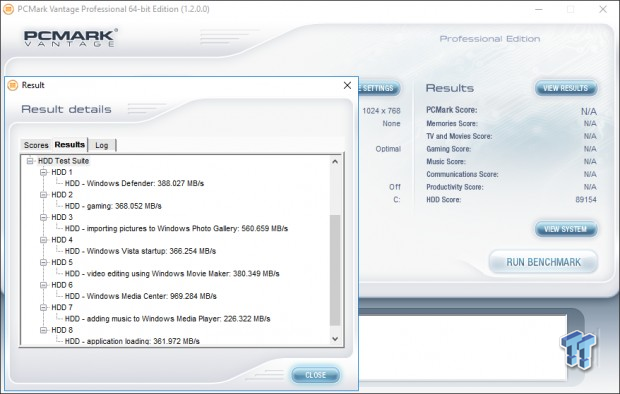
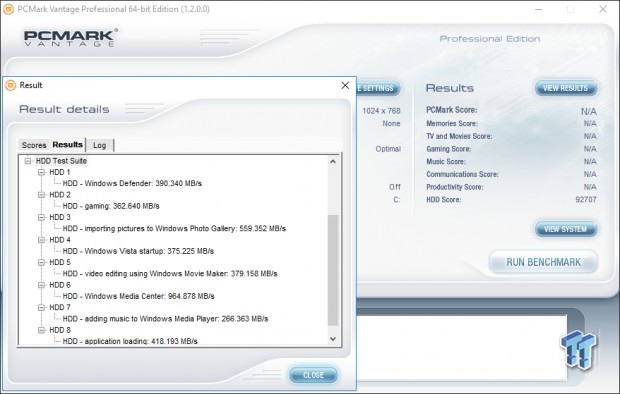
OS Volume 75% Full - Steady State
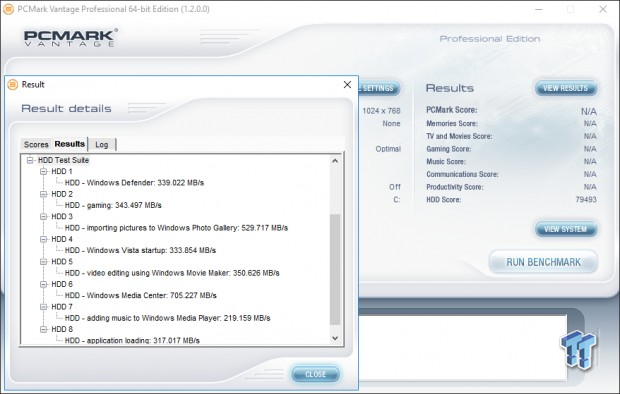
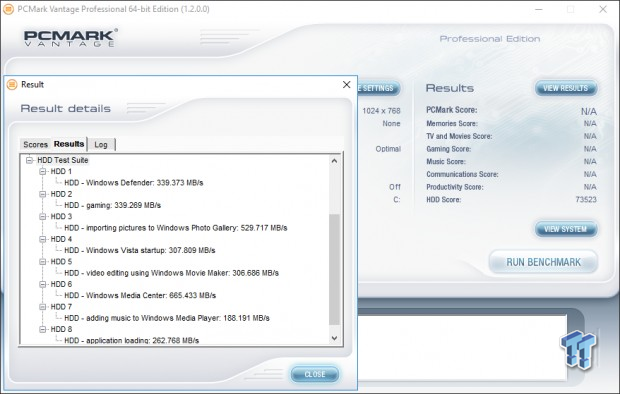
Secondary Volume Empty - FOB
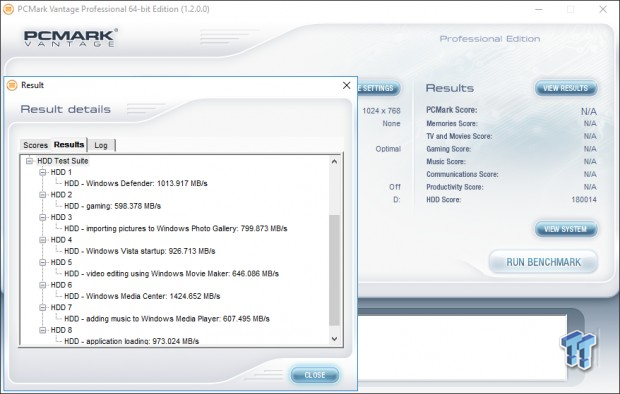
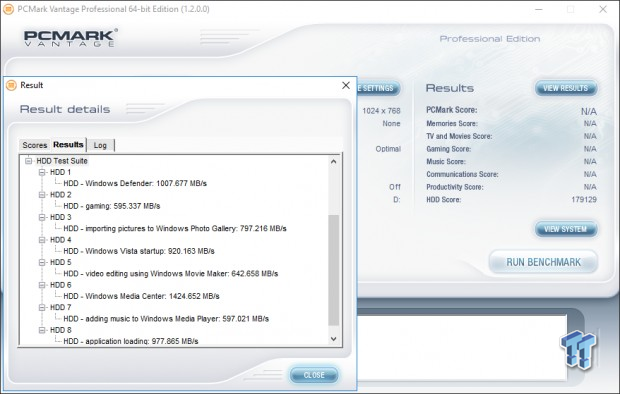
There's a big difference between an empty drive, one that's 75% full/used, and one that's in a steady state.
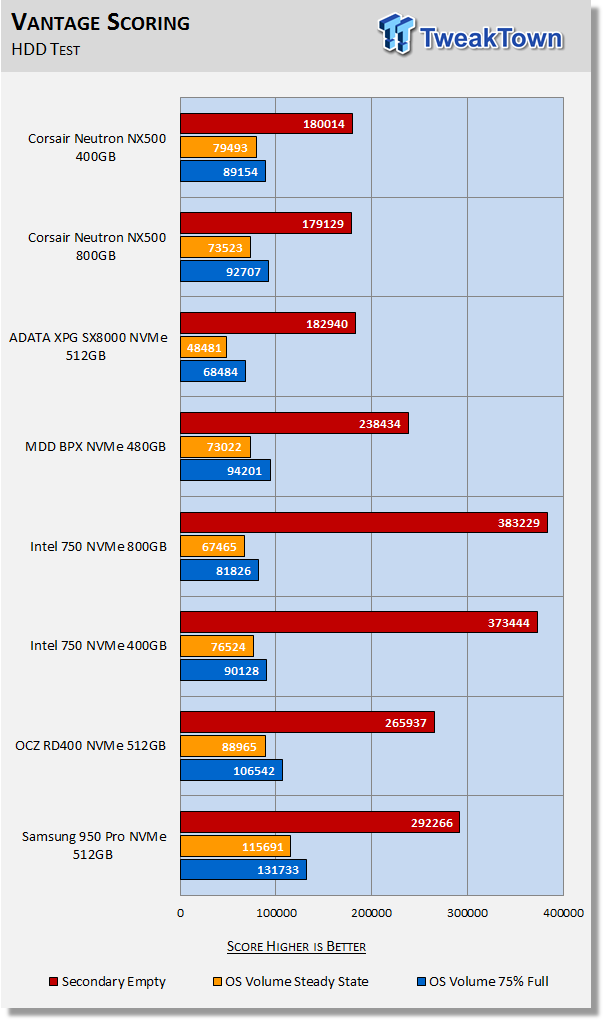
The important scores to pay attention to are "OS Volume Steady State" and "OS Volume 75% full." These two categories are most important because they are indicative of typical of consumer user states. When a drive is in a steady state, it means garbage collection is running at the same time it's reading/writing.
Focusing in on 75% full and steady state performance, we see the NX500 delivering performance that is comparable to or better than Intel's 750 series. The MDD BPX delivers far better performance than the NX500 when empty, but empty scores are meaningless as demonstrated by Intel's 750 series. The 400GB NX500 has the upper hand over the 800GB model when running in a steady-state.
PCMark 7 - System Storage
Version and / or Patch Used: 1.4.0
We will look to Raw System Storage scoring for evaluation because it's done without system stops and, therefore, allows us to see significant scoring differences between drives. When evaluating NVMe SSDs, we are looking for a minimum score of 11,000
OS Volume 75% Full - Lightly Used
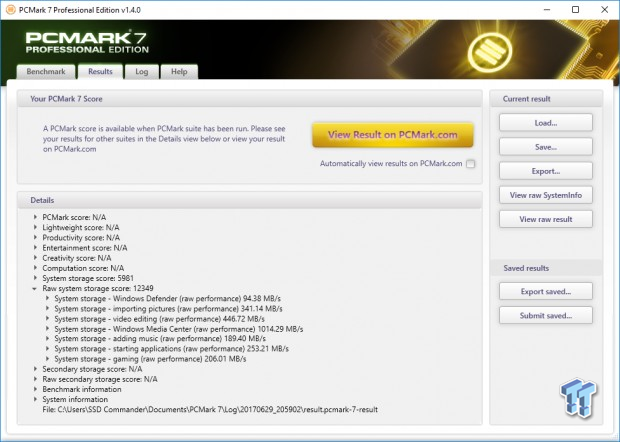
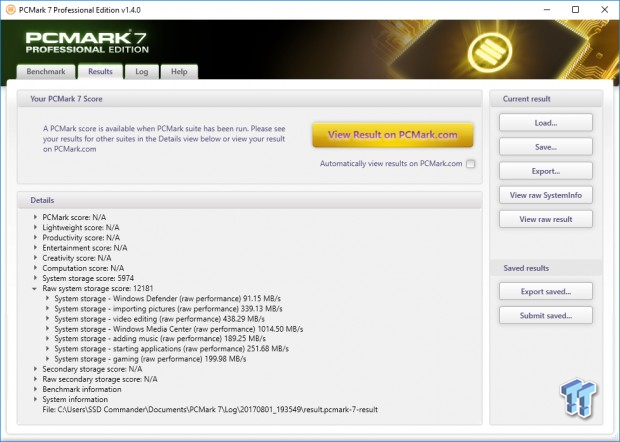
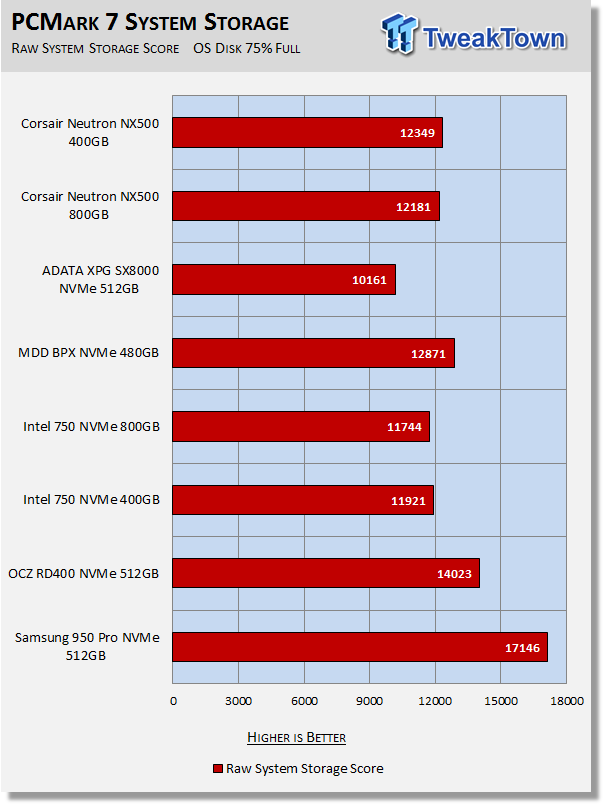
The NX500 at both capacity points exceed our minimum score of 11K. The BPX with its larger SLC cache delivers a better score than the NX500. The RD400 handily outperforms the NX500 primarily because the RD400 has the benefit of a dedicated NVMe driver. The 950 Pro leaves everyone in the dust due to its superior random performance at low queue depths. The NX500 does defeat Intel's 750 series when running this moderate workload simulation.
PCMark 8 - Storage Bandwidth
Version and / or Patch Used: 2.4.304
We use PCMark 8 Storage benchmark to test the performance of SSDs, HDDs, and hybrid drives with traces recorded from Adobe Creative Suite, Microsoft Office, and a selection of popular games. You can test the system drive or any other recognized storage device, including local external drives. Unlike synthetic storage tests, the PCMark 8 Storage benchmark highlights real-world performance differences between storage devices.
OS Volume 75% Full - Lightly Used
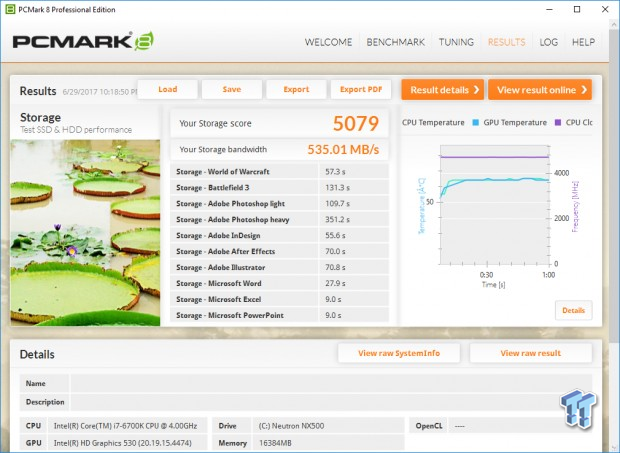
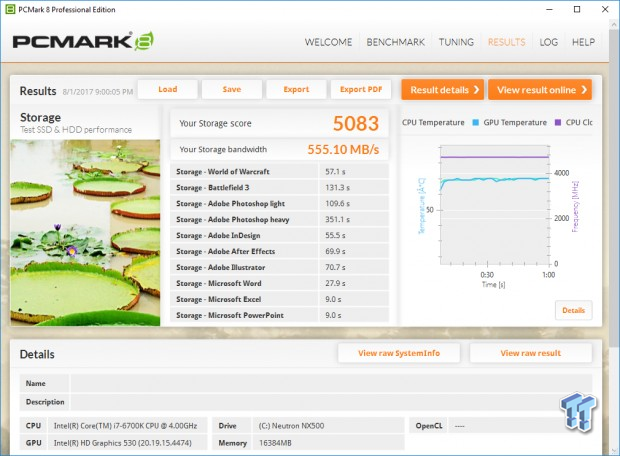
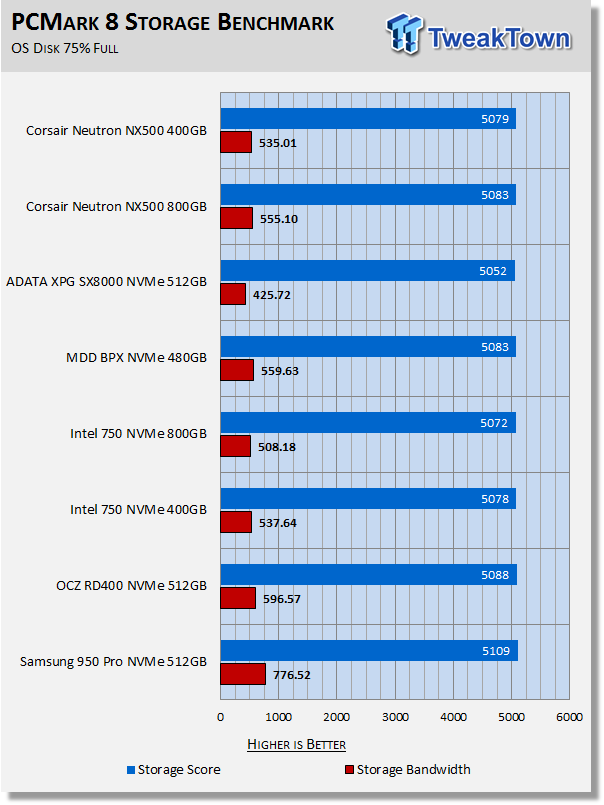
PCMark 8 is the most intensive moderate workload simulation we run. With respect to moderate consumer type workloads, this test is what we consider the best indicator of a drive's performance.
Note: We have reevaluated the way we have been presenting our PCMark 8 scoring as bandwidth performance only. We are now placing more importance on the Storage Score than the Storage Bandwidth, because the Storage Score takes into account latency as well as bandwidth.
This time the 800GB NX500 delivers better performance than the 400GB model. The BPX delivers more storage bandwidth but scores identical to the 800GB NX500. This is due to the NX500 having better (lower) latency. In terms of scoring, the 400GB NX500 delivers a better Storage Score than the 400GB Intel 750 even though the 400GB Intel 750 delivers more Storage Bandwidth.
BAPCo SYSmark 2014 SE Application Performance
Version and / or Patch Used: 2.0.0.70
SYSmark 2014 SE is considered the gold standard for testing system performance because it is an application based benchmark. This test gives us the ultimate in real-world results because it utilizes actual applications running on the system, instead of playing back recorded traces. If you want to know what kind of impact a particular SSD will have on your system's overall performance; this test will show you.
Please note: We have reevaluated the way we chart SYSmark. We have decided that the Overall Rating more accurately represents an SSDs impact on system performance than does the Responsiveness Score on its own.
Our systems are much more powerful than the calibration system (1000-point baseline) used by BAPCo, so we ran an OCZ TL100 120GB SATA III SSD to establish a comparison point relative to our test systems. We will be running this test going forward, and we will add drives to our chart as we test them.
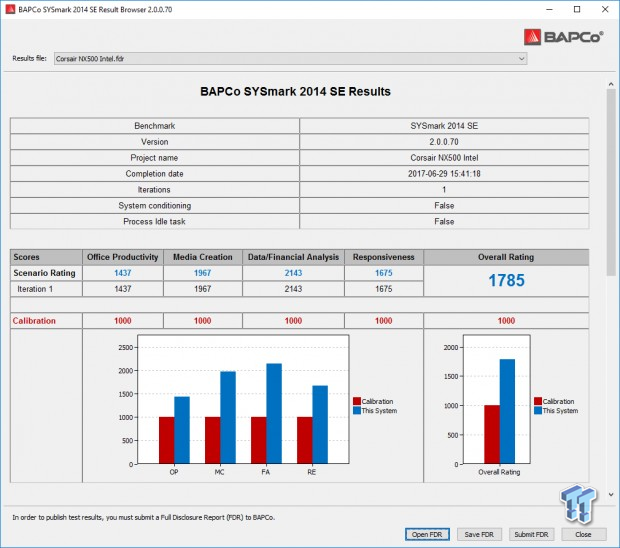
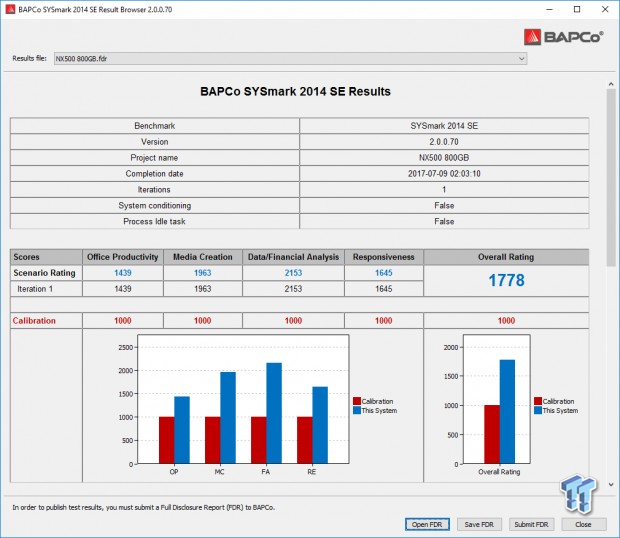
It is important to keep in mind that with SYSmark 2014 SE a few points are a big deal when comparing one drive to another on the same platform.
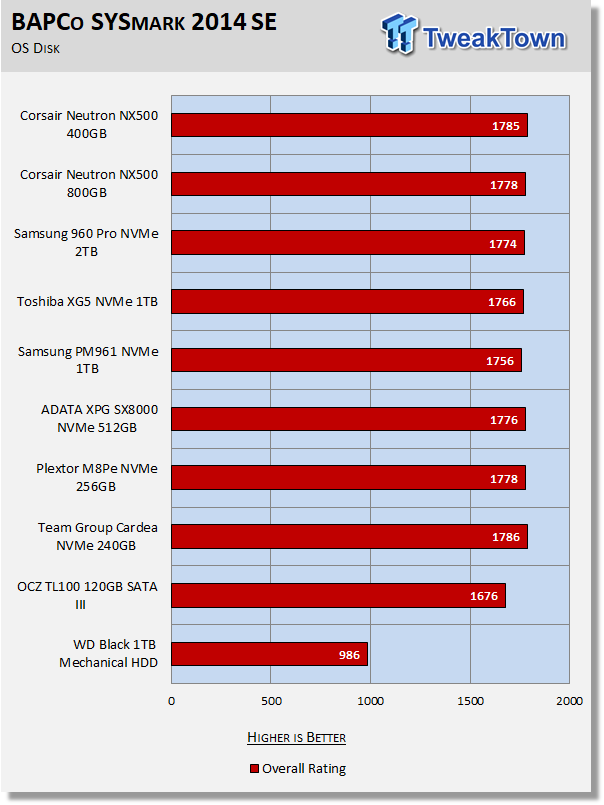
We don't have a lot of SSDs for comparison yet, but we've been able to identify a pattern. Phison E7 powered SSDs deliver unmatched system performance as measured by SYSmark. The E7 SSDs on our chart all deliver better system performance than we are getting from Samsung's mighty 960 Pro 2TB SSD. This is something we believe our readers should take notice of. As we've stated before, the user experience we get from E7 powered SSDs is really as good as it gets for a flash-based SSD.
Benchmarks (Secondary) - IOPS, Response & Transfer Rate
Iometer – Maximum IOPS
Version and / or Patch Used: Iometer 2014
We use Iometer to measure high queue depth performance. (No Partition)
Max IOPS Read
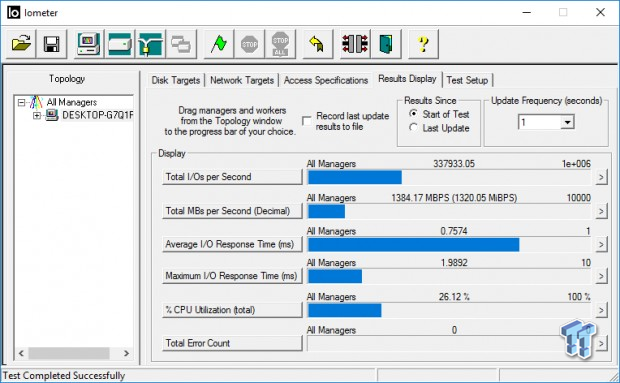
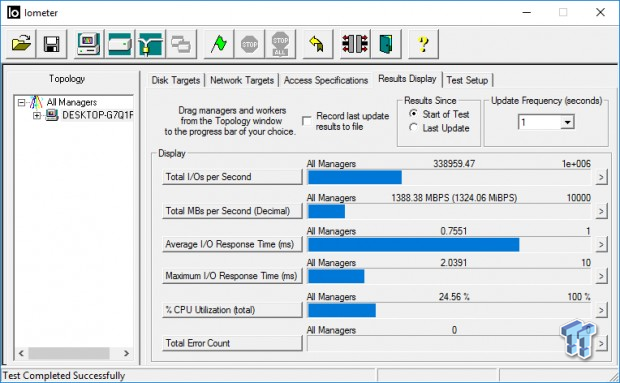
Max IOPS Write
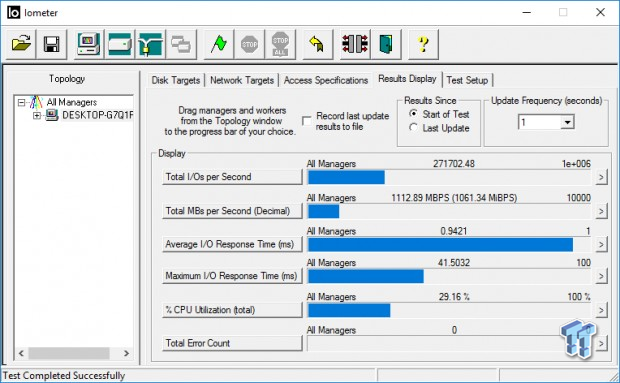
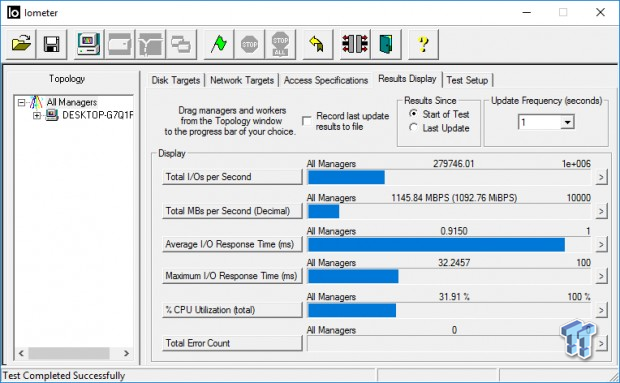
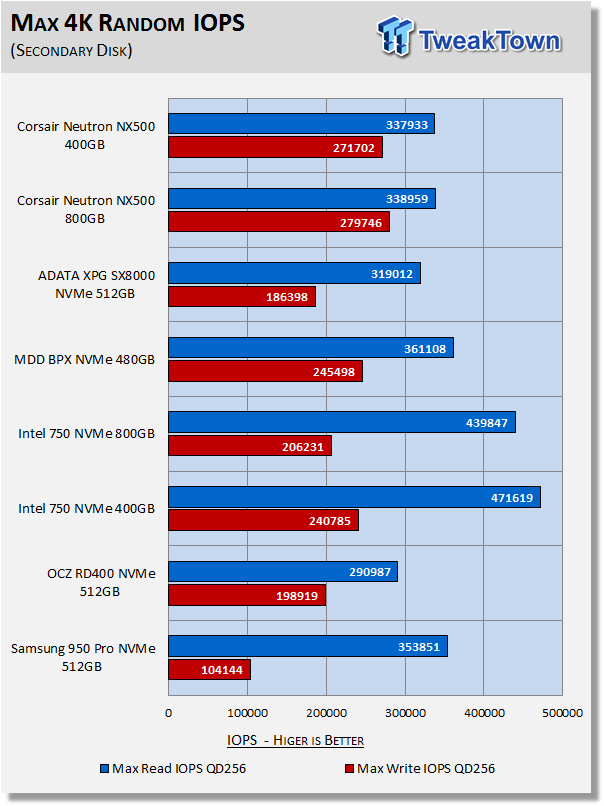
We test NVMe SSDs using eight threads at QD32, or QD256. We do this because we want to see what the drive can generate at its maximum attainable queue depth. Both capacity points are able to exceed Corsairs stated maximum 4K random performance.
Iometer – Disk Response
Version and / or Patch Used: Iometer 2014
We use Iometer to measure disk response times. Disk response times are measured at an industry accepted standard of 4K QD1 for both write and read. Each test runs twice for 30 seconds consecutively, with a 5-second ramp-up before each test. We partition the drive/array as a secondary device for this testing.
Avg. Write Response
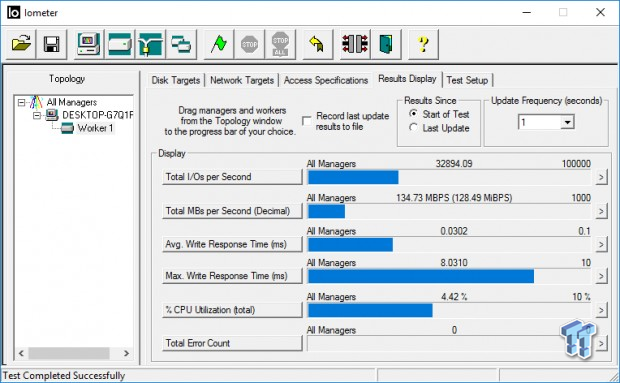
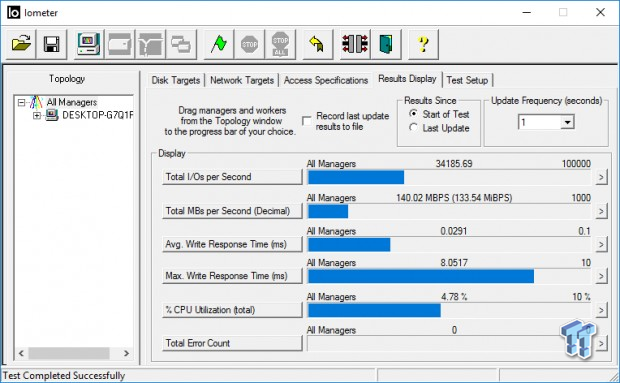
Avg. Read Response

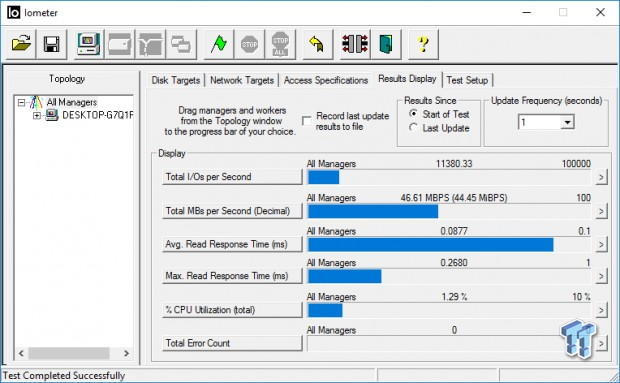
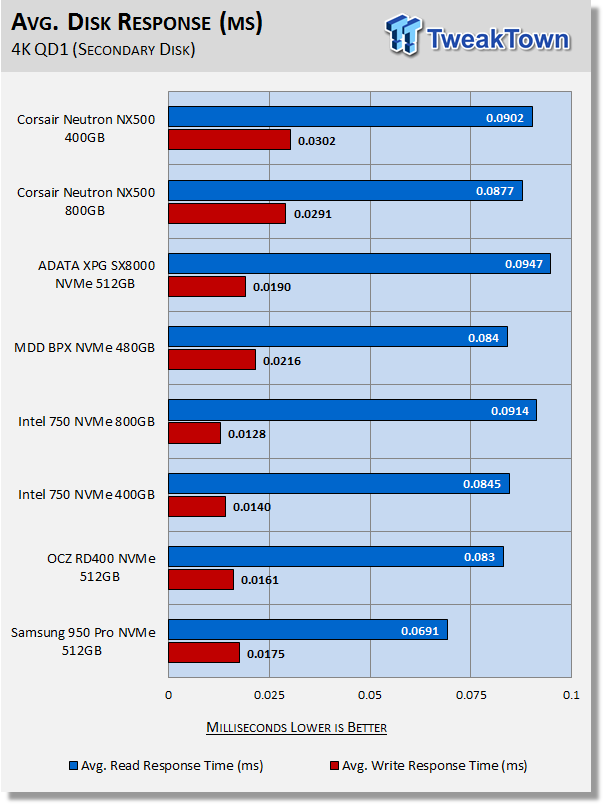
Comparing disk response of the NX500 to the BPX shows us the performance decline in low queue depth performance between E7 drives running on 2.1 and those running on 4.x firmware. We have been told that the reduction in SLC cache capacity increases reliability.
DiskBench – Transfer Rate
Version and / or Patch Used: 2.6.2.0
We use DiskBench to time a 28.6GB block (9,882 files in 1,247 folders) composed primarily of incompressible sequential and random data as it's transferred from our Toshiba RD400 1TB NVME SSD to our test drive. We then read from a 6GB zip file that's part of our 28.6GB data block to determine the test drive's read transfer rate. Our system is restarted prior to the read test to clear any cached data, ensuring an accurate test result.
Write Transfer Rate
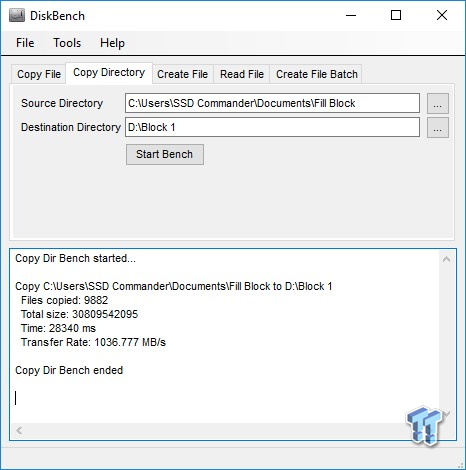
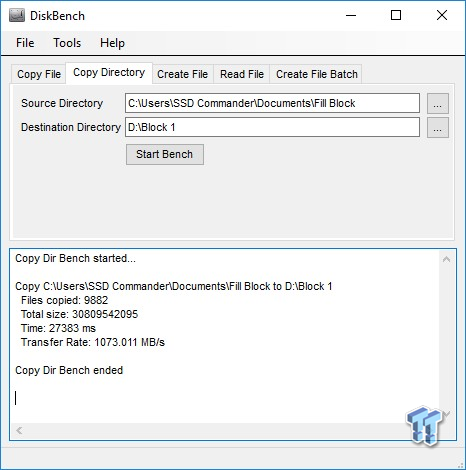
Read Transfer Rate
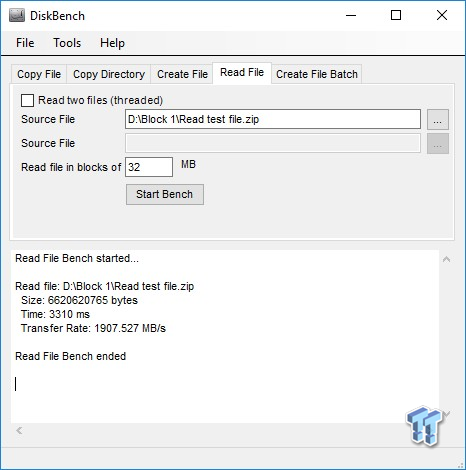
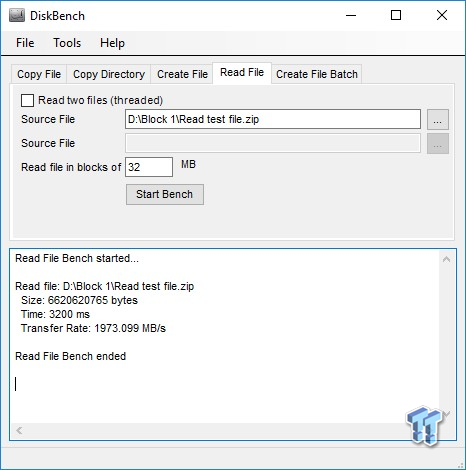
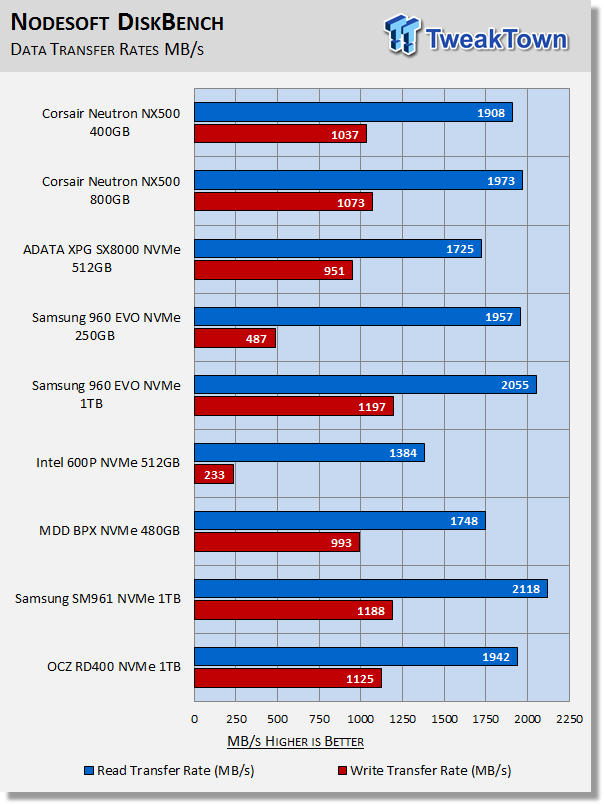
We recently upgraded our test system to Windows 10 build 14393. With that upgrade, write transfer rates almost doubled. The reason for this, as far as we know, is that CPU power switching modes have been relaxed on the latest version of Windows 10. We included the NVMe drives we've tested to date on this build of Windows 10. If you needed a good reason to upgrade to a newer version of Windows 10; this is a good reason.
The NX500 doesn't deliver the absolute best transfer rates, but they are still what we would consider tier one performance. If we compare the transfer rates of the NX500 to those of the value oriented BPX, we see the NX500 performs significantly better.
Benchmarks (Secondary Volume) – PCMark 8 Extended
Futuremark PCMark 8 Extended
Heavy Workload Model
PCMark 8's consistency test simulates an extended duration heavy workload environment. PCMark 8 has built-in, command line executed storage testing. The PCMark 8 Consistency test measures the performance consistency and the degradation tendency of a storage system.
The Storage test workloads are repeated. Between each repetition, the storage system is bombarded with a usage that causes degraded drive performance. In the first part of the test, the cycle continues until a steady degraded level of performance has been reached. (Steady State)
In the second part, the recovery of the system is tested by allowing the system to idle and measuring the performance after 5-minute long intervals. (Internal drive maintenance: Garbage Collection (GC)) The test reports the performance level at the start, the degraded steady-state, and the recovered state, as well as the number of iterations required to reach the degraded state and the recovered state.
We feel Futuremark's Consistency Test is one of the best tests ever devised to show the true performance of solid state storage in an extended duration heavy workload environment. This test takes on average 13 to 17 hours to complete and writes somewhere between 450GB and 14,000GB of test data depending on the drive. If you want to know what an SSDs steady state performance is going to look like during a heavy workload, this test will show you.
Here's a breakdown of Futuremark's Consistency Test:
Precondition phase:
1. Write to the drive sequentially through up to the reported capacity with random data.
2. Write the drive through a second time (to take care of overprovisioning).
Degradation phase:
1. Run writes of random size between 8*512 and 2048*512 bytes on random offsets for 10 minutes.
2. Run performance test (one pass only).
3. Repeat 1 and 2 for 8 times, and on each pass increase the duration of random writes by 5 minutes.
Steady state phase:
1. Run writes of random size between 8*512 and 2048*512 bytes on random offsets for 50 minutes.
2. Run performance test (one pass only).
3. Repeat 1 and 2 for 5 times.
Recovery phase:
1. Idle for 5 minutes.
2. Run performance test (one pass only).
3. Repeat 1 and 2 for 5 times.
Storage Score, Storage Bandwidth
PCMark 8's Consistency test provides a ton of data output that we use to judge a drive's performance.

We consider steady state bandwidth (the blue bar) our test that carries the most weight in ranking a drive/arrays heavy workload performance. Performance after Garbage Collection (GC) (the orange and red bars) is what we consider the second most important consideration when ranking a drive's performance.
The NX500 demonstrates the best performance we've seen from an E7 powered SSD. However, with the exception of the SX800, the NX500 is outperformed by the rest of the drives in our test pool. Part of the reason for this is that the better performing SSDs in our test pool are greatly benefiting from the use of proprietary NVMe drivers.
Storage Bandwidth Per Phase
We chart our test subject's storage bandwidth as reported at each of the test's 18 trace iterations. This gives us a good visual perspective of how our test subjects perform as testing progresses. This chart sheds more light on how the drives perform as they progress through the testing phases.
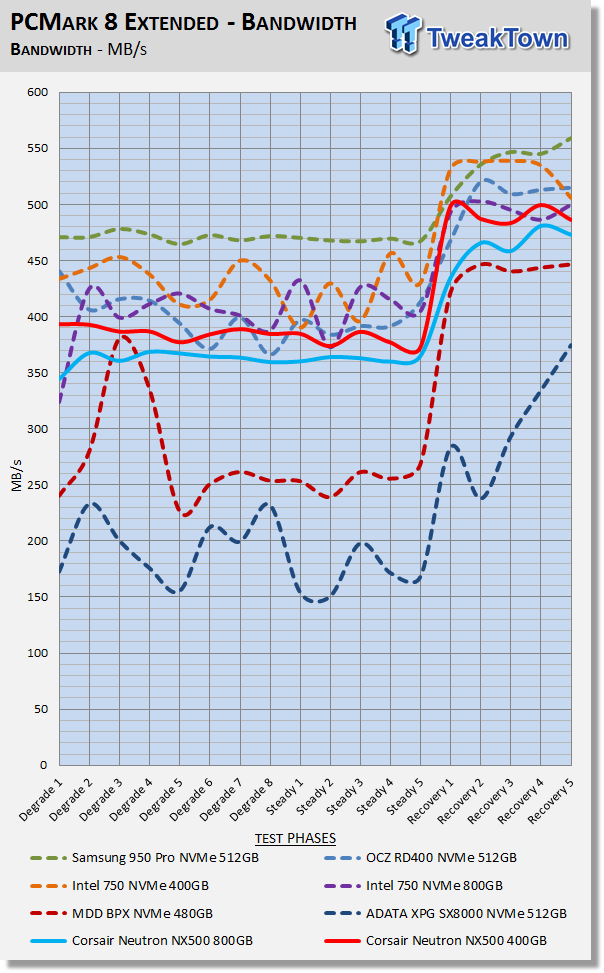
Total Access Time (Latency)
We chart the total time the disk is accessed as reported at each of the test's 18 trace iterations. This helps shed some light on how the drive performs at each of the 18 phases of this test.
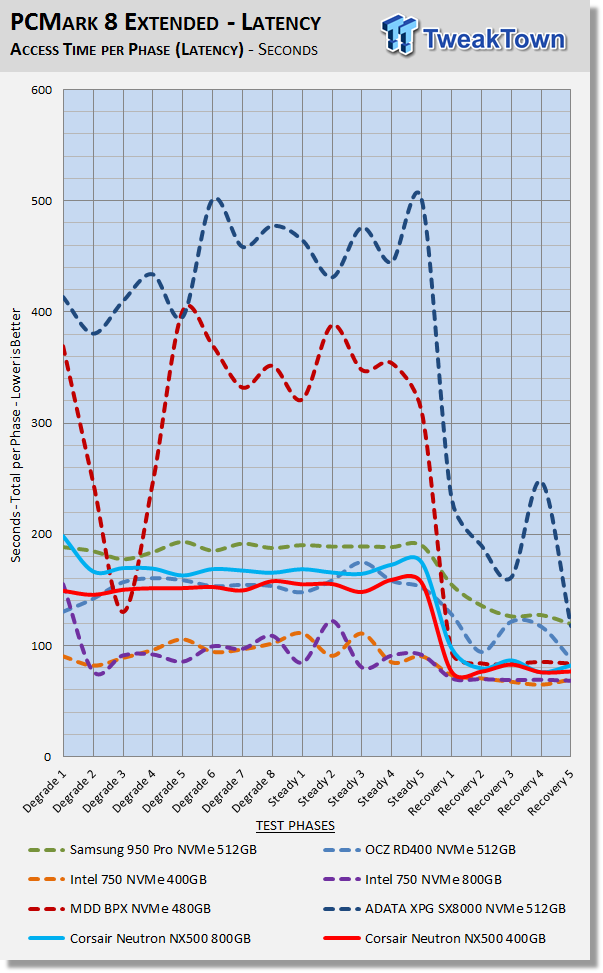
Disk Busy Time
Disk Busy Time is how long the disk is busy working. We chart the total time the disk is working as reported at each of the tests 18 trace iterations.
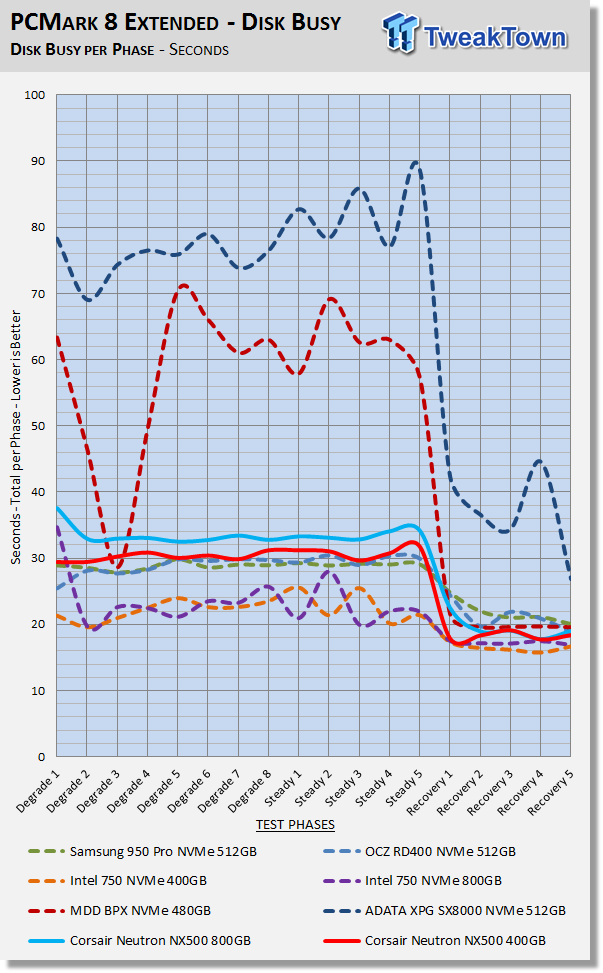
Data Written
We measure the total amount of random data that our test drive/array is capable of writing during the degradation phases of the consistency test. Pre-conditioning data is not included in the total. The total combined time that degradation data is written to the drive/array is 470 minutes. This can be very telling. The better a drive/array can process a continuous stream of random data; the more data will be written.
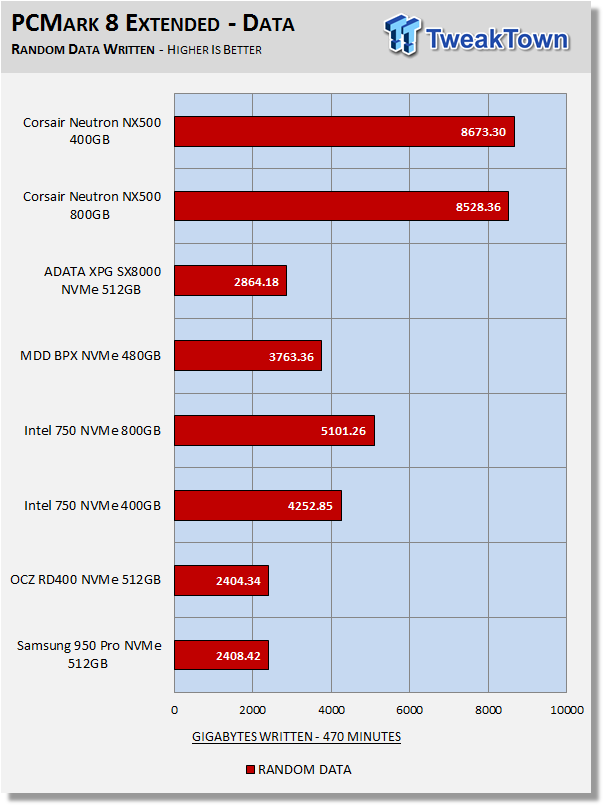
Overprovisioning and write latency are the biggest factors that determine the outcome of this portion of the test. Both of these enterprise-like attributes pay off big time for the NX500. The NX500 sets a new lab record; crushing Intel's 750 series in the process.
Benchmarks (Secondary Volume) – 70/30 Mixed Workload
70/30 Mixed Workload Test (Sledgehammer)
Version and / or Patch Used: Iometer 2014
Heavy Workload Model
This test hammers a drive so hard we've dubbed it "Sledgehammer." Our 70/30 Mixed Workload test is designed to simulate a heavy-duty enthusiast/workstation steady-state environment. We feel that a mix of 70% read/30% write, full random 4K transfers best represents this type of user environment. Our test allows us to see the drive enter into and reach a steady state as the test progresses.
Phase one of the test preconditions the drive for 1 hour with 128K sequential writes. Phase two of the test runs a 70% read/30% write, full random 4K transfer workload on the drive for 1 hour. We log and chart (phase two) IOPS data at 5-second intervals for 1 hour (720 data points). 60 data points = 5 minutes.
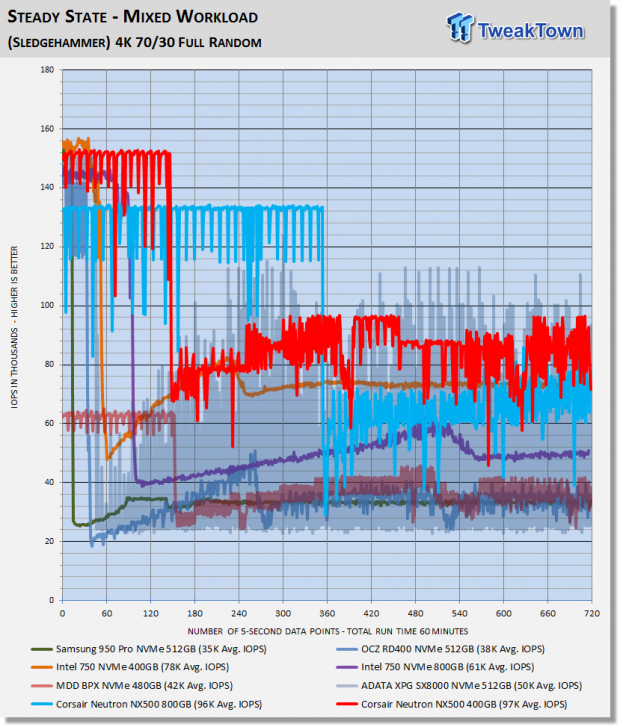
What we like about this test is that it reflects reality. Everything lines up, as it should. Consumer drives don't outperform Enterprise-Class SSDs that were designed for enterprise workloads. Consumer drives based on old technology are not outperforming modern Performance-Class SSDs, etc.
Once again, the NX500 takes Intel's 750 series to the woodshed and demolishes the rest of the competition in the process. To get a good idea of what overprovisioning does for heavy sustained workloads, just compare the 950 Pro to the NX500. The 950 Pro is the faster drive, but not when running enthusiast level workloads.
Maxed-Out Performance (MOP)
This testing is just to see what the drive is capable of in an FOB (Fresh Out of Box) state under optimal conditions. We are utilizing empty volumes of Windows 10 and Windows Server 2012 R2 64-bit for this testing.
Windows 10 MOP
Corsair Neutron NX500 400GB AIC PCIe NVMe SSD
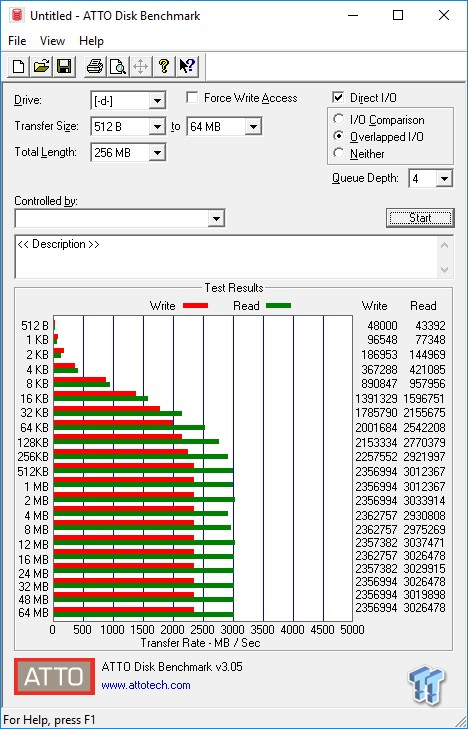
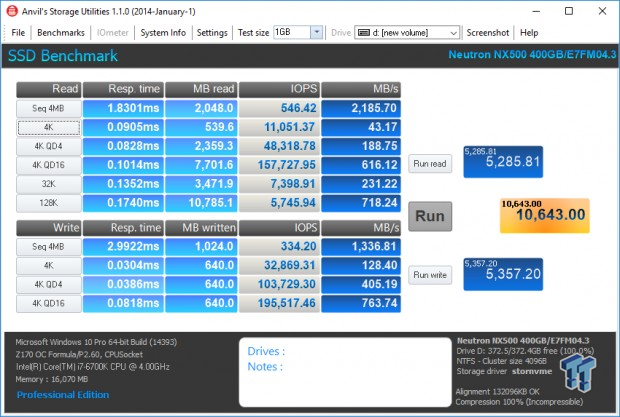
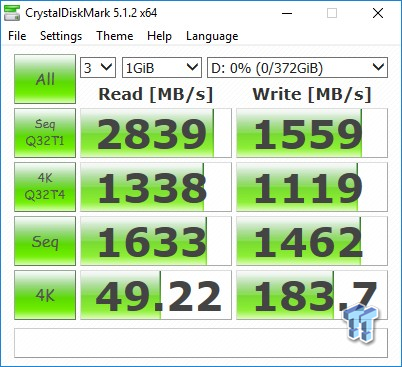
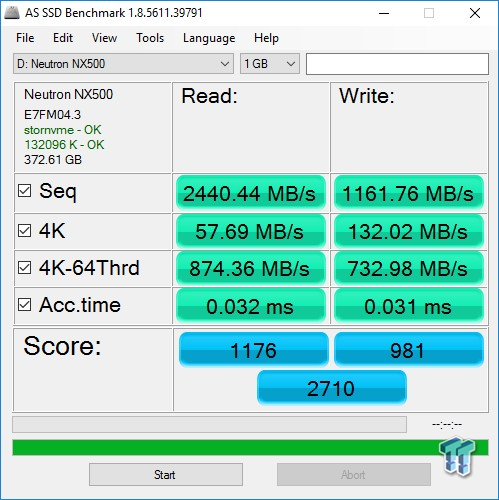
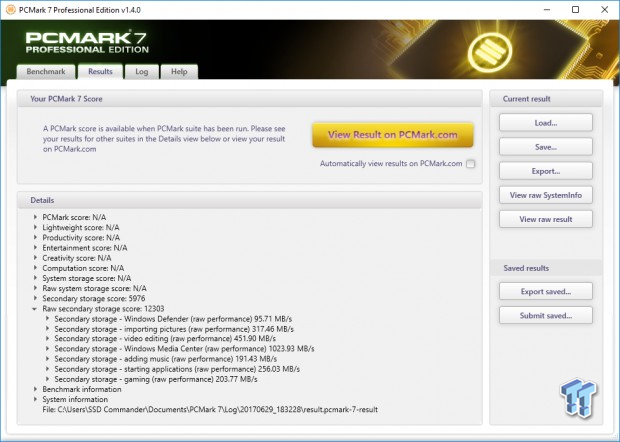
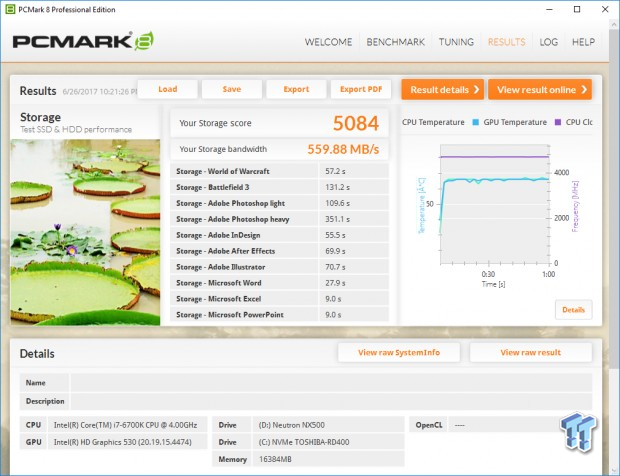
Windows 10 MOP
Corsair Neutron NX500 800GB AIC PCIe NVMe SSD
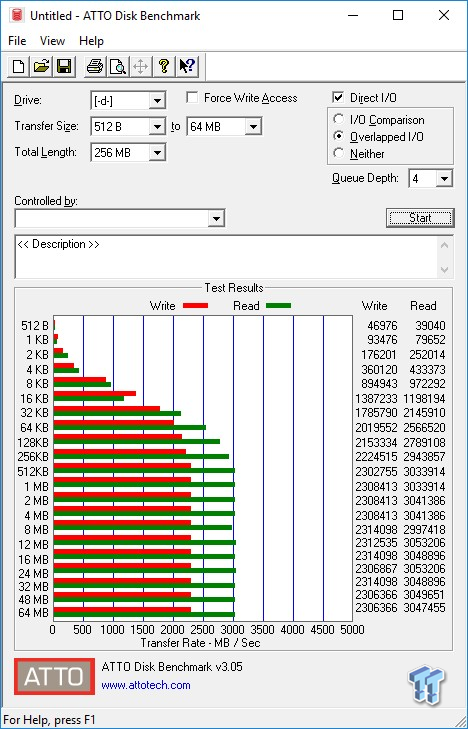
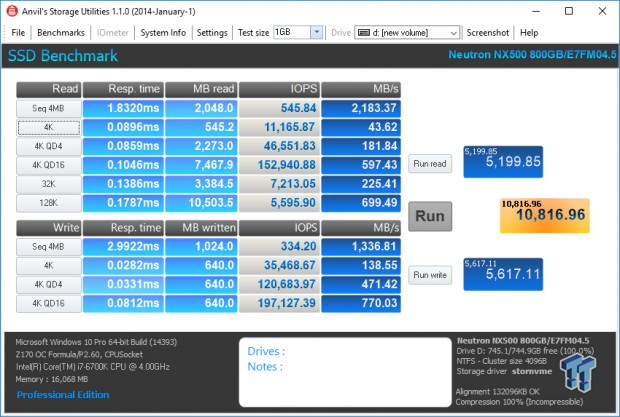
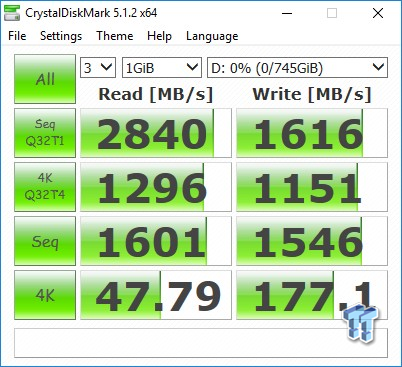
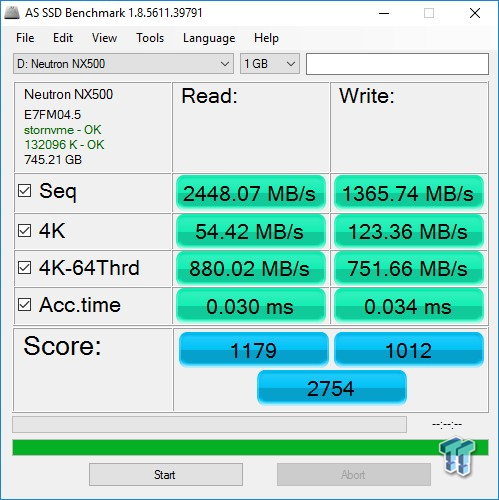

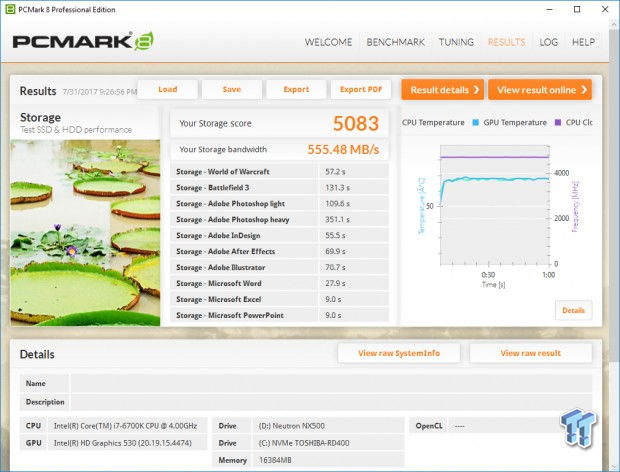
Windows Server 2012 R2 MOP
Corsair Neutron NX500 400GB AIC PCIe NVMe SSD
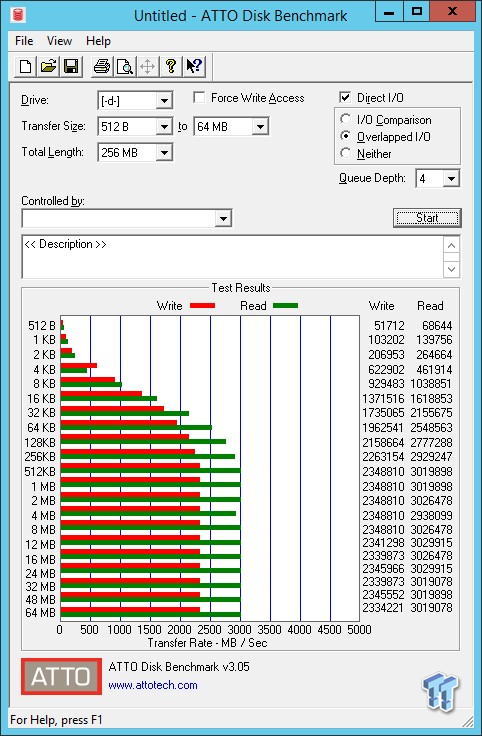
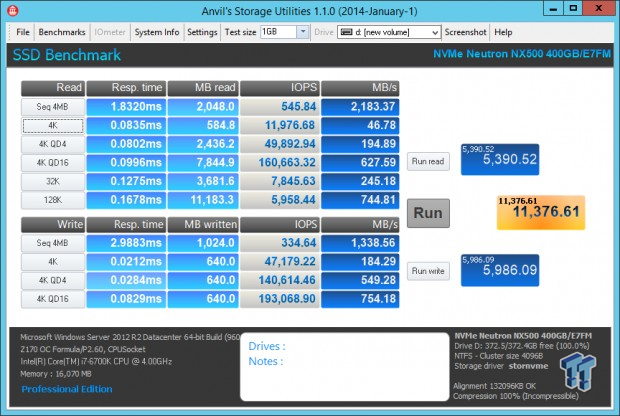
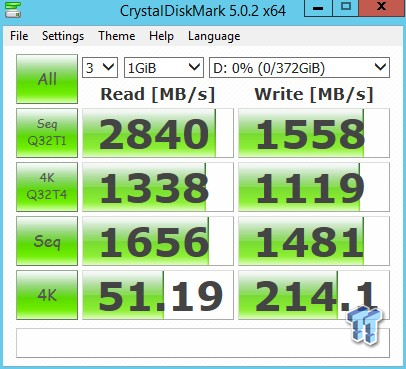
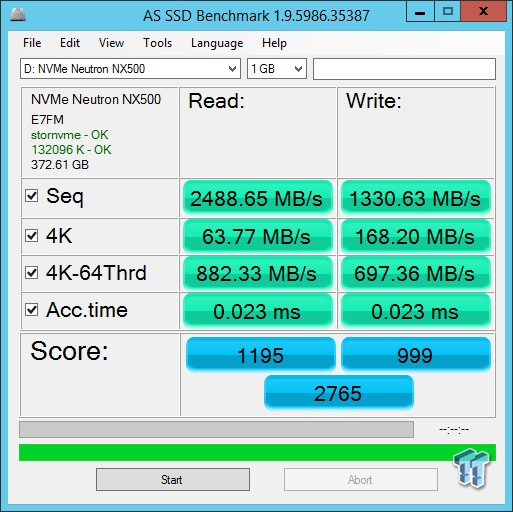

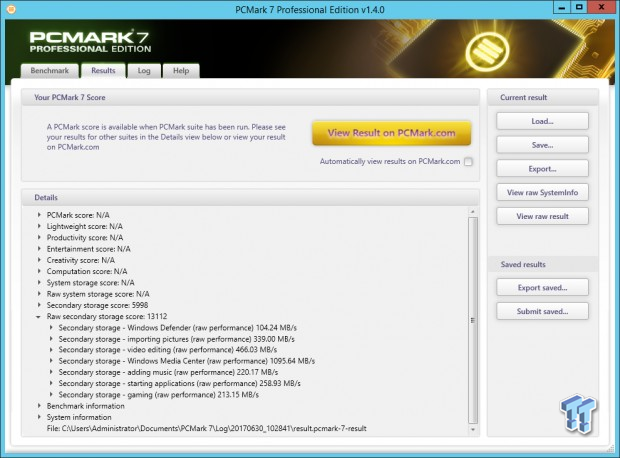
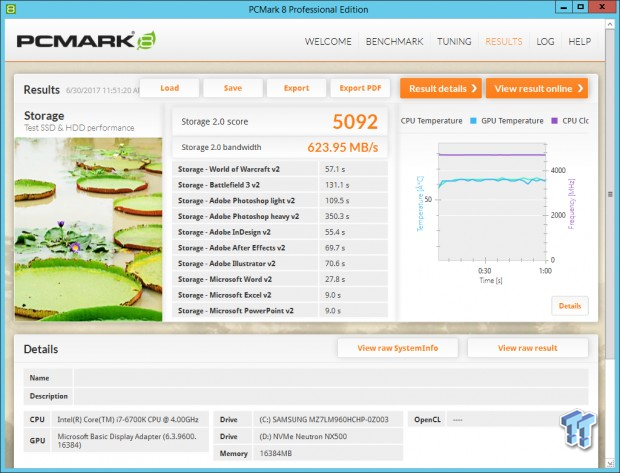
Windows Server 2012 R2 MOP
Corsair Neutron NX500 800GB AIC PCIe NVMe SSD
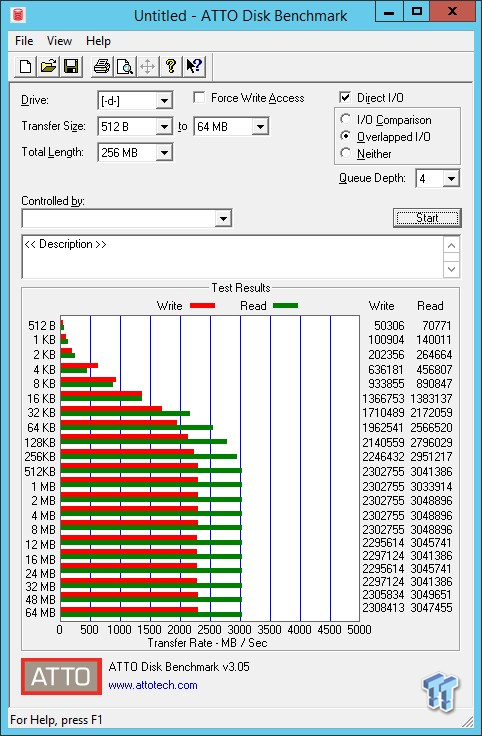
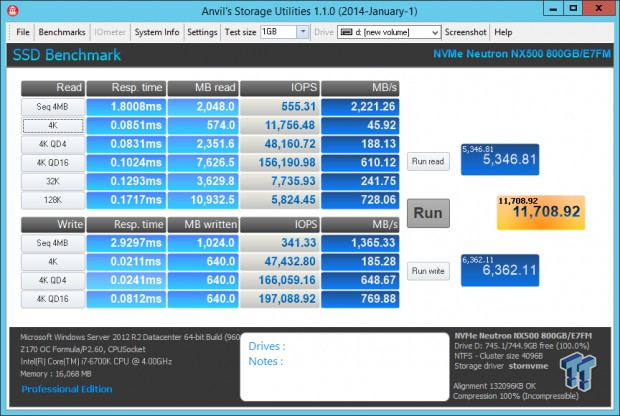
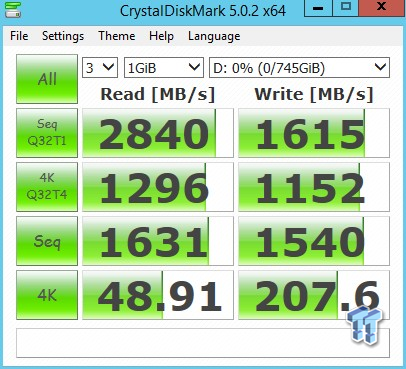
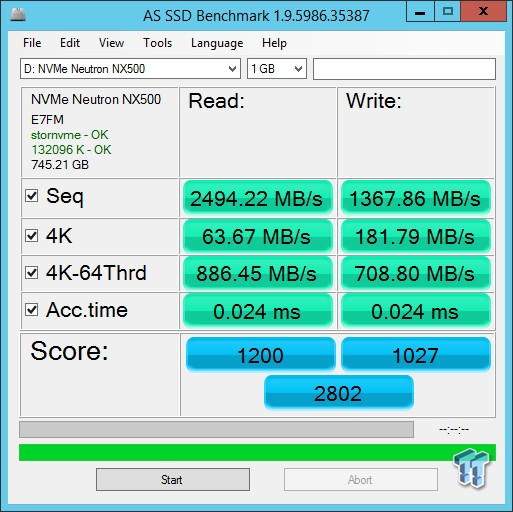
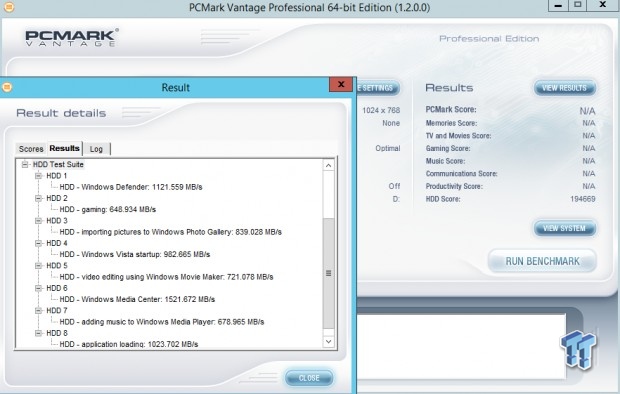
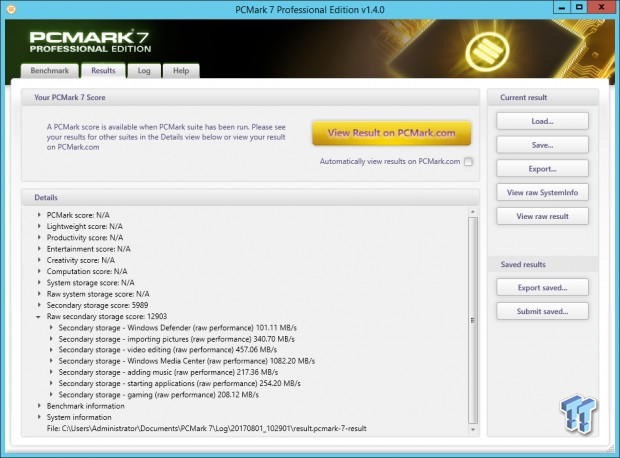
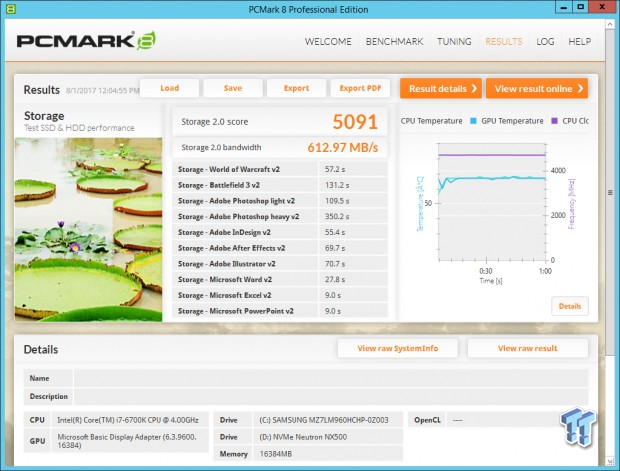
Final Thoughts
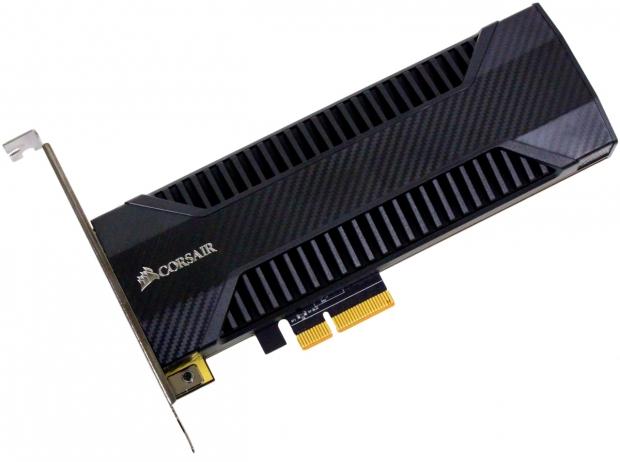
Enthusiast grade is what Corsair's NX500 is all about. Overall, the NX500 gives us what we want. The NX500 delivers the best sequential performance of any Phison E7 powered SSD we've tested to date. We believe that some of the increase in sequential performance we are seeing comes at the expense of random performance. The NX500 running on 4.x firmware doesn't give us quite as good random performance as we've come to expect from E7 powered SSDs running on older firmware; especially 2.1 firmware.
We asked Phison about their reasoning behind the slightly scaled back random performance that goes hand-in-hand with 4 series firmware. Phison told us that 4.x firmware reduces the available SLC cache and that they did this to increase the drives reliability to an appropriate level for an enthusiast grade piece of hardware. We, of course, tend to lean toward the more performance, the better, but in the end, reliability is the paramount consideration.
The NX500 is a drive that is priced considerably more than many other SSDs of the same capacity. However, in the case of Corsair's NX500 you are paying for - quality over quantity. In our opinion, the NX500 is worth the extra coin because you get a drive that can handle the most demanding tasks with ease and a drive that stays nice and cool while doing it.
As we always say, it all comes down to user experience, and Corsair's NX500 delivers it in spades. As we mentioned earlier in the review, the NX500 delivers a tier-one user experience that rivals the fastest SSDs ever made, which is why Corsair's NX500 is TweakTown recommended.
Pros:
- Heavy Workload Performance
- Premium Components
- Sleek Design
Cons:
- Burst Performance
- Cost

